
OHEL CHRONICLES
Topics of this page:
Chanukka 5777 / Our celebration on December 30th, 2016
Sukkot 2016 in GatowOctober 8, 2016: Reb Goldie Milgram is visiting Ohel Hachidusch
Shavuot, June 12, 2016 / Sivan 6, 5776
Planting Festival 2016
Passover 5776 – 2016
December 5, 2015: Jonas Samuele is Bar Mitzvah
October 30 and 31, 2015: Tehillim Workshop with Chazzan Jalda Rebling
Sukkot 2015 - Erev Tishri 5776
Tashlikh in Gatow 2015
Shavuot 5775 / 2015
May 10, 2015: Planting Day in our green shul
Our Seder on April 4, 2015
Purim 2015
January 24, 2015: Noa is Bat Mitzvah
November 16, 2014: Mitzvah Day at Ohel Hachidusch
November 15, 2014: Bejt HaChidusch visits Ohel HaChidusch
Sukkot 5775
August 17, 2014: Our Zalman-Fest
June 28, 2014: Welcome as our new Bat Mitzvah, dear Mathilda
Ohel Hachidusch and our wimpl as guests in Erfurt
Passover 2014
Tu b´Shevat 2014 and our Planting Festival
November 24, 2013: We handicraft our own Chanukkah Candles
November 17, 2013: Mitzvah Day in Germany
May 26, 2013: A Philosopher Introduces Her New Book
May 5, 2013: Planting Day in Gatow
April 12 -13, 2013: Shabbaton with Cantor Jalda Rebling
January 26, 2013: Shabbat Beshallach: Simchat Chochmah and Tu biShevat
December 22, 2012: Our first Bat Mitzvah Celebration
Simkhat Torah 2012/5773
Erev Sukkot 2012 - 5773
Rosh Hashanah 2012 - 5773
Tu b´Av 5772/ August 3, 2012:
Donna is our "Writing Girl"
July 1, 2012: Rabbi Tsvi Blanchard visits Ohel Hachidusch
Erev Purim 2012
Pesakh 2012 - 5772: 2nd Seder in the tent of Ohel Hachidusch
Tu Bishvat 2012
Global Day of Jewish Learning: November 13, 2011
Sukkot 2011/5772
Tishri 24, 5772 - Shabbat Bereishit-: Our first Bar Mitzvah
Minkha Learning Session with Reb Dr. Goldie Milgram from USA
Eco-Kashrut II: Our field in summer 2011
Lag b´Omer and Eco-Kashrut
Pesakh 2011 - 5771
Learning Session for Lilith and a very special menorah
Tu biShevat 2011
Learning Celebration in memory of Rabbi Leo Trepp
Sukkot_2010
Ohel Hachidusch moved to a new home (June 2010)
Beth Jacob Torah in Berlin
January 2010: Photographs of Chajim´s ceramics, our wimple and Ohel-documentation in Shir Tikvah
Article of Rabbi Arnie Sleutelberg about our Torah Celebration 28th of November 28, 2009 and his visit to Berlin
Report of our Torah Celebration 28th of November 2009
For other articles on our previous activities please click archive
Chanukka 5777 / Our celebration on December 30th, 2016
Far away from the hustle and bustle of Berlin, our Ohelistas gathered their friends and families in the Remise in Gatow. The big iron stove churned out a calming warmth and light, shrouding the whole room in twilight and coziness despite the wintery weather outside.
One after another, they all arrived: Big and small, the children with their handmade Chanukkiot, the adults with their own, handed down to them by the trusty hands of tradition from their mother, father or other relatives.
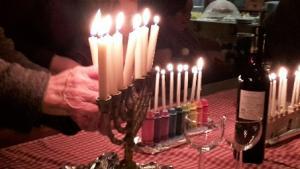
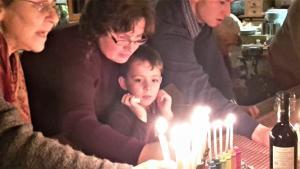


It was wonderful to see that the ‘temple band’ prepared songs and handed out lyric sheets so all could sing along. As Jalda began the celebration, the room was packed with faces full of expectation – and ever more arrived.
The question was: Which candles to light first? Since it was also the beginning of Shabbat, nobody was quite sure of the answer… But soon came the solution: Of course you would have to light the Channukka lights before lighting the Shabbat candles, as you aren’t allowed to work – or light candles – on Shabbat. And as soon as this issue was sorted out, the children in particular couldn’t be stopped anymore – They wanted to see their beautiful Chanukkiot shine!
But wait! From what side do you start lighting the candles? Left to right? The other way around? The newest candle first? What’s with the ninth candle? Which Brachot are there to say? This time, Jalda didn’t leave us in the dark for too long and explained to us the purpose of the ‘Shamash’. Soon all was clear as day: left to right, ‘newest’ candle first.
And then we told the story of Chanukka. We told of our battle against the occupying forces, their decree forbidding the Jewish way of life and our rites of celebration, our commemoration days and our access to the temple. We told of our ruses to continue teaching in the Jeshiwa. We told of the Dreidel game as a deception during inspections. We heard of the strong women fighting for the resistance from the underground in acts of guerrilla warfare. Every war is ugly and gruesome, but at least in this case, it was inevitable. We heard of the role of women fighting side by side and on eye level with the men.
And of course, we told of the most important part; of success and victory, of ejection and the retreat of the enemy; of the restoration of the temple that was almost a complete reconstruction, so severe was its defilement. And then of the seeming impossibility of the temple’s candles burning long enough until new blessed oil could be produced – 8 long days, although the pitiful remaining rest was barely enough to light them for a single day.
We also discussed the apparent connection between Christmas and Chanukka, the superficial similarities, but also the grave differences and the impossibility of comparing the two.
All had gathered around the many burning Channukka candelabras and listened spellbound. It is a festival of lights, of joy even, but as so many of our holidays also one that was created by desperation and persecution. Between all the beauty and joy, there is also a more serious, contemplative note to it.

For every Jewish holiday, there has to be a tasty and expansive feast – again crowned by Rita’s delicious soup and the many different dishes that were brought. Not to forget the conversations between one another, as the opportunities to meet everyone are way too few and far between.
The temple band ensured good vibes and offered many songs to sing along to, ending a wonderfully bright and shiny evening. L’Chaim!
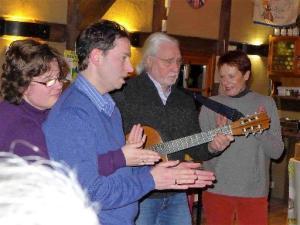
Text: Esther Trapp Translation: Joseph Rebling
Photos: Anna Adam and Esther Trapp
Sukkot 2016 in Gatow
As at many beautiful Sukkot festivities previously, Anna built the framework of the Sukkah from old disused wooden pallets and battens with expert hand and skillful helpers in Rita's garden. The Ohelistas came one after the other. At the approach they were enchanted by the wonderful smell of the wood fire in Rita's and Uli's court of the Gatower remise. Cantor Jalda, the children, and all the folks of Ohel Hachidusch went to the field to harvest it enthusiastically, so that it might beautify the sukkah and our harvest festival. Many beautiful pumpkins, quinces, but also shrubbery of pumpkin for the roof of our sukkah could still be found in the field. Likewise carrots, onions, chard and fennel, as well as sage. And right, Anna, her helpers, and the children built and decorated the most beautiful sukkah Ohel Hachidusch ever had.
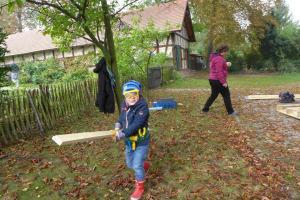

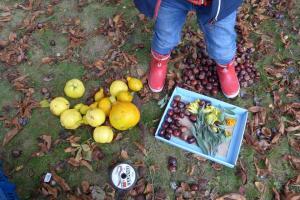


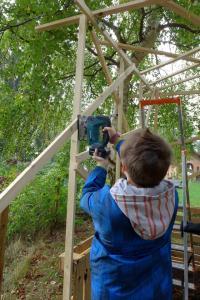

And certainly the only one in Berlin which had a pomegranate tree with fruit at the entrance.
This one, lovingly nursed by Rita Reinicke in the Botanicum, was lent to us especially for our Sukkah. The fruit is mentioned several times in the Torah. The pomegranate has 248 nuclei, as many as there are positive mitzot. With its many precious stone fruit cores, it is primarily a symbol of unity in diversity, of abundance and creative creativity, of renewal and fertility.

But before celebrating kiddush in our sukkah and the subsequent meal in Rita and Uli Reinicke´s autumnally decorated carriage house, let me add a small excursion:
No Jewish holiday is more popular among American and Israeli environmentalists than Sukkot. With its agricultural roots and its commandment to be connected to nature in provisional huts for a week, Sukkot is the sine qua non of Jewish environmental protection. What is more beautiful than what was cultivated by ourselves, eaten and drunk in a sukkah, and under seasonally appropriate fruits hanging from the roof rafters?
Every year we produce a massive Co2 footprint when we make a feast of overflow at Sukkot instead of realizing its message of living more sustainably and more in accordance with the seasons. From an environmental point of view, also etrog and lulav, the branches of the palm tree, myrtle, brookweed, the complete festive bouquet - are problematical. They are flown in from Israel and sent massively to Jewish communities, which cannot grow palm trees or etrog groves because of the winter season. The mitzvah of the arba mimin, the commandment of the use and shaking of the four species required for Sukkot, was regulated at a time and in a place where these four species were abundant, regional and renewable. When Maimonides wrote Hilchot Sukkah, in which he explained the commandment of etrog and lulav, he lived in Egypt, where etrog, palm tree, bovine pastures, and myrtle leaves were to be found as easily a good cup of coffee in Rome nowadays.
Surrounded by children, cantor Jalda stands inside the beautiful sukkah and asks the children, "Can you see the sky through the roof?" And when they say yes, Jalda declares the sukkah as kosher and says kiddush with her beautiful voice.
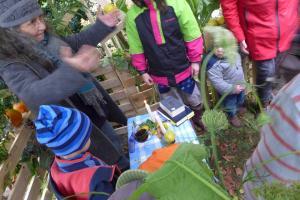
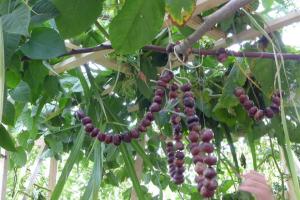
And so cantor Jalda reminded us at dinner of the tradition known to all Jews, according to which Rabbi Jochanaan said: The lulav is turned in the honor of G-d, for G-d belongs to the four heavenly directions; It is held up and down for the glory of G-d, for G-d is heaven and earth.
Just as the citrus fruit has a taste as well as a sweet smell, there are people in Israel who are both learned and live their faith.
As the fruits of the palm branch have taste but are odorless, there are in Israel people who are learned, but do not live their faith.
As the branches of myrtle have a pleasant smell, but are inedible, there are people who do good works, but are not learned.
As the branches of the brookweed are neither edible nor do they have a pleasant smell, there are people who are neither learned nor do they do good works.
But all belong together.
For, as it is said, G-d, baruch hashem,says: "Let Israel not perish, let them all be bound together, as plants are bound together, into a covenant, so that the righteous among them will effect the atonement of the others. And referring to us, cantor Jalda reminded us, that we too are often one or the other, and only together we are a blessing.
And so we used the quince of Jalda's tree on our field instead of the etrog.
For the palm branch there was a branch of a palm tree in the pot.
There was the local brookweed from Rita's garden and the myrtle from a flower pot. All these ingredients for the lulav we have picked from our field and the Botanicum.
As Anna wrote me, the idea of replacing imported plants with local ones originally came from Rabbi Jan Salzman from Vermont / USA, now Rabbi in Burlington / USA.
One more excursion to the rabbis: They say that everything that exists on earth has its spiritual counterpart in heaven. When you think about Sukkot, you wonder if G-d would have a Sukkah in a spiritual sense. And if so, what would He use for the s'chachon, for the roof above the structure? We used the cut stalks and leaves of the pumpkin plants of our field. The remains of our harvest.
During Rosh Hashanah, the days of repentance, and at Yom Kippur, we confess our mistakes and blindness before G-d.. We aim to remedy these mistakes and renew ourselves. The rabbis say that in the effort in which we transform ourselves into better human beings, abandoning the errors and doing Teshuvah, every recognized sin becomes a stepping stone for the good. Every transgression is lifted from the low place of its emergence into a position of honor, and brings us closer to G-d. Perhaps the husks and blends from which the s'chachon, the roof of G-d's Sukkah is built, are the mistakes we have made? The uglier and the lower the fault was which was expiated at Yom Kippur, the more simcha (joy) it brings to G-d's Sukkah.
That´s the way it is: When we sing and eat and drink in the shadow of the abandoned shoots of the plants of our garden and field, amidst the fruits of the field, G-d is perhaps sitting under the clippings of his vineyard and shouting a joyous le-chayim toward us. And when He does that, delighted with His harvest, He looks through the cuts of the past year and now discovers in them the blessings. And so we eat and drink gratefully in the warm, comfortable retreat in Gatow, which Rita and Uli so nicely prepared for us, devoting ourselves to Anna´s and the Ohelistas expert sukkah building arts and Jalda's beautiful voice and blessed words. We eat Rita's tasty pumpkin soup, which was boiled on a fragrant wood fire in the yard, and enjoy Rita's delicious cheesecake as well as our other home-made food and challah. Chag Sameach!
Text: Romy Koecher Photos: Anna Adam
Translation: Etha Jimenez and Joseph Rebling
October 8, 2016: Reb Goldie Milgram is visiting Ohel Hachidusch
Rabbi Dr. Goldie Milgram was our special guest at Shabbat Shuva / 6th of Tishri 5777.
It began with a welcome in the Remise by Hazan Jalda Rebling. Then Reb Goldie lead us through a wonderful meditation in the Botanicum, a paradisaical place a few meters farther, with its endless abundance of just-flowering plants in their last days of flowering. Once more, the autumnal golden-growing leaves of the lush extensive trees lit Reb Goldie Milgram´s ´minchah meditation in a very special light for us. Rita Reinicke had planted a botanical garden in the large garden of the estate, divided into four areas: Judaism, Christianity, Islam and Buddhism. The plants therein are those, which are mentioned in the texts of the respective religion. In the Jewish part of the garden you can find sage, pomegranates, olives and wine. In the Buddhist area there is a ginkgo tree, in the Christian part there is a monastery garden with medicinal herbs mentioned by Hildegard von Bingen, and in the Islamic part we grow mint and beautiful Damask roses.
Rabbi Dr. Goldie Milgram from Philadelphia (USA) has written numerous books on contemporary Jewish topics. She is no unknown to us. She visited us 5 years ago in the Remise of the Gatow grange, so we were very happy to welcome her back to us and learn from her. Rabbi Milgram was ordained by the Reconstructionist Rabbinical College. She founded and led the Reclaiming Judaism Press and www.ReclaimingJudaism.org, an organization which, among other things, developed new strategies to keep Jewish rituals and mitzvot alive and to renew them.
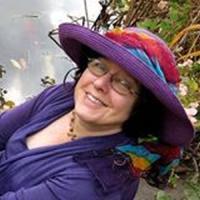 www.facebook.com
www.facebook.com In addition to her books, Rabbi Milgram produced interesting materials on this subject, such as her Mizvot cards, from which she presented to us a rich selection. Again it was an exciting and intensive learning experience for us and we were very grateful to benefit from the Mizvah of time for learning and teaching, which Reb Goldie dedicated to us. Our discussion with Reb Goldie was about the mitzvah of giving, but also about the opposite, the inability to give, as she vividly explained in the final story of Ashley.
Reb Goldie told us:
Ashley lived with her beloved, Randy, near a beach with baby-powder-fine sand and
serene cerulean gulf waters.
Now Ashley was not always a considerate person when it came to little things. Little
things like pointing out to her elderly father that he had lost something when that didn’t
really need to be mentioned, or leaving her dishes in the sink for Randy to wash. Rather
than making the effort of doing so, Ashley never recycled anything and she always
blamed others for her own mistakes.
While she certainly knew better, still Ashley never regretted these things. She never
apologized or did teshuvah. Every Friday, she just wrote down her sins and errors and
shoved them, like so much dirty laundry, into a bag. One, by one, they went ⎯ each
aveirahiii, chataiii (thump your chest), avoneiv, and peshav— into a spare laundry bag
which was not being used otherwise because it was sooooo huge.
For Ashley, Tashlich was just a habit, a rote rite, something everyone performed, and
which she did because her parents had always taken her to do it. And so, every year,
come the first day of Rosh HaShannah, she would drag that year’s bulging bag down to
the river for Tashlich.
Now even a little aveirah tends to be remembered by at least someone, somewhere.
These things can catch up with a person, as Ashley was about to discover.
It happened that, more than anything in the world, Ashley and Randy wanted to have
children. They had tried every means for this to be so, ever so many medical
interventions, taking capsules from promising infomercials and, eventually, Chinese
herbs, acupuncture, even cupping, lighting candles in churches, taking capsules, biting
off the end of the etrog, and more!
Until, one day, Randy heard about a holy woman, called Tzadeket Tsurah, who lived in
aAshley lived with her beloved, Randy, near a beach with baby-powder-fine sand and
serene cerulean gulf waters.
Now Ashley was not always a considerate person when it came to little things. Little
things like pointing out to her elderly father that he had lost something when that didn’t
really need to be mentioned, or leaving her dishes in the sink for Randy to wash. Rather
than making the effort of doing so, Ashley never recycled anything and she always
blamed others for her own mistakes.
While she certainly knew better, still Ashley never regretted these things. She never
apologized or did teshuvah. Every Friday, she just wrote down her sins and errors and
shoved them, like so much dirty laundry, into a bag. One, by one, they went ⎯ each
aveirahiii, chataiii (thump your chest), avoneiv, and peshav— into a spare laundry bag
which was not being used otherwise because it was sooooo huge.
For Ashley, Tashlich was just a habit, a rote rite, something everyone performed, and
which she did because her parents had always taken her to do it. And so, every year,
come the first day of Rosh HaShannah, she would drag that year’s bulging bag down to
the river for Tashlich.
Now even a little aveirah tends to be remembered by at least someone, somewhere.
These things can catch up with a person, as Ashley was about to discover.
It happened that, more than anything in the world, Ashley and Randy wanted to have
children. They had tried every means for this to be so, ever so many medical
interventions, taking capsules from promising infomercials and, eventually, Chinese
herbs, acupuncture, even cupping, lighting candles in churches, taking capsules, biting
off the end of the etrog, and more!
Until, one day, Randy heard about a holy woman, called Tzadeket Tsurah, who lived in
a nearby town, and told Ashley about hirvi discovery.
“Randy,” Ashley said, “That is wonderful! Next week I will go to see if the tzadeket
can help me have children. Maybe she can work a miracle for us!”
When Ashley arrived at the house of the Tzadeket, she barged right in without knocking
and found the family in the kitchen. “Tzadeket Tzurah! I need your help for us to have
children. No matter the cost, be assured, we will pay.”
Tzadeket Tzurah looked at Ashley, then down at the floor, up at the ceiling and out
through the window in silence. And then she replied, “Having children isn’t like
bargaining over a contractor’s bid for an addition to your house. Please sit down. I am
going to have to pray about this.”
As her family left the kitchen to give them space, Tzadeket Tzurah went to the stove
and soon brought over a pot of tea and plate of cookies for her guest.
Ashley began wolfing down the cookies, without so much as a thank you.
Tzadeket Tzurah looked at Ashley, then down at the floor, up at the ceiling and out
through the window in silence. She then closed her eyes and began to rock, chanting a
niggun and then prayed aloud: “Holy Shechinah! Show me what I must know, what
Ashley must do, tell us what can be? Children are needed, babies for a yearning couple!
Please help us!”
After a very long time, a large tear ran down the face of Tzadeket Tzurah. She opened
her eyes, looked at Ashley, then down at the floor, up at the ceiling and out through the
window and began chanting the niggun again.
Soon Ashley shouted: “Stop the singing! Why the huge tear? Tell me my answer
already!”
Tzadeket Tzurah finished chanting, sat silently with her eyes closed for what seemed
like forever. Then she opened her eyes and said: “Be grateful for what you have and do
not ask for more.”
“What a ridiculous answer!” Ashley cried out, leaping up. “Old fool, do you even know
what you are doing? Why would you say such a bizarre thing to me?!”
Tzadeket Tsurah was overtly undeterred by Ashley’s style and replied: “Ashley, dear
soul, sit down, please tell me, what was life like in your home growing up?”
As Tzadeket Tzurah listened, she began nodding and sometimes touching her cheek
with one hand, moving her head right and left as she did, and at the end wiped away the
one tear that would not be held back. Great rachamim, compassion, had arisen with her,
and so she spoke with empathy to Ashley, reflecting the elements of the story back,
using Ashley’s words where possible, ever so carefully. At the end of her retelling she
passed a box of tissues to Ashley, as Ashley wept and wept.”
After sharing a second cup of tea together in silence, Ashley turned to Tzadeket Tzurah
and said: “Enough of that, children don’t come from feeling sorry for oneself. I am here
for you to work a miracle for us, for we must have children and at this age there’s not
time to waste. And really, how can I be grateful for what I do have, when we still do not
have children!” Rising from her seat again, Ashley declared: “I should leave now, for
you are obviously no Tzadeket!” She then paused and, looking thoughtfully, she added
slowly, “Well, there’s a chance you misheard, so how about you repair your reputation
by trying again, before I get back to the neighborhood where Randy and I live.”
Tzadeket Tsurah replied, her voice still gentle: “Ashley, did you think you could get
away with this forever? With treating people so inconsiderately?” Her voice becoming
more forceful, she added: “Ashley, you have polluted the sea with your huge bags of
aveirot and more. Any children of yours will suffer terribly.” “And,” her voice softened
again, “Please don’t ask me what will happen to them; I can’t bear to tell you.”
Ashley responded without hesitation: “Having children is a risk I’m willing to take and
we have tried everything to have them!” She paused, sat back down, and a tear ran
down her face as she added in an unexpectedly earnest small voice: “We yearn for
children. We have tried every possible way to conceive before coming to you. Please,
there must be some way, you are our last chance, surely there must be a way.”
Tzadeket Tsurah sat quietly, looking gently at Ashley, and finally replied: “We can try
one more thing, but I cannot promise that you will like the outcome. First I need a piece
of paper; please give me a sheet of that rice paper on the shelf over there, and the
fountain pen beside it. Thank you… Now I need a needle from this small bowl on the
table. Yes, this one will do. Come with me to the stove, we must sterilize this needle
over the flame….Good. Let’s go and sit down. I must prick your finger and write upon
the paper in Aramaic, as is the tradition; your blood will be the ink…
“Ouch,” shouted Ashley, “that hurt!”
“I’m sorry,” said Tzadeket Tzurah, writing rapidly. “See, blood dries quickly. Soon you
will be able to fold this document into a small square.”vii
Next, from a carved wooden box on the table, Tzadeket Tzurah withdrew a tiny muslin
bag on a string, and placed the paper into it, saying: “Randy must wear this segulah,
this amulet, constantly, while you continue trying by all possible means to conceive. If
you do so, in ten months you will birth twins, but (ominous pause) …. they will be with
you for only five years.”
“What have you written? Woe, no!” cried Ashley. “If there is to be danger to the twins,
you must let me know how to save them!”
“Given your ways, I’m sorry to say, that is not possible,” replied Tzadeket Tzurah.
“What terrible prophesy is this?! My ways are my ways, I’m a successful business
woman, I have done just fine as I am, and I am not about to change.” cried Ashley. She
then fell silent, thinking, thinking, thinking, and then she had an Aha moment! And she
added: “Tzadeket Tzurah, as the bearer of such terrible tidings, surely you owe me a
clue as to how to save my twins. You must give me something, something helpful to go
on!” And then her voiced dropped coyly, “At least for the sake of the children.”
Tzadeket Tzurah thought to herself, “How to help this troubled young woman at this
point on her journey? I have given her my best advice, and a chance to withdraw her
request, but now she has me cornered.” As she had learned from her teacher of her
teacher’s teacher’s teacher, the Tzadeket, the holy woman Hannah Rochel of
Ludomir,viii Tzadeket Tsurah looked down, releasing the tension in her body, and up
asking for guidance, and then out the window, letting go of her thoughts, and began to
chant her teacher’s niggun for melitz yosher, the ancient, uncommon, yet still presentin-
our-times Jewish practice of requesting guidance from the soul of a wise deceased
sage.ix And aloud she prayed: “Tzadeket Hannah Rochel, on the merit of your many
good deeds and teaching of Torah, please add your prayer for this couple to have
children, and show me the next step to help Ashley in her desire to parent.” From that
point on Tzadeket Tsurah appeared to be praying silently, her lips moving alternately
with the nodding of her head, listening and then sitting in silence, and ending with a
brief chanting of the same niggun aloud.
“Ashley, I have been told your situation merits one clue… (quietly take and release a
breath to ensure a brief pause) …one and only one clue as to how to save the twins”.
(Pause again…) “The clue is this: If you mend your ways, reducing your bag of
aveirot, avonot, chataot, and p’sha’im to the level of a considerate, mitzvah-centered
person for the rest of your life… (pause and speak even more slowly) ... then, on the
day that you put two socks on one foot, you will be able to save the twins.”
Ashley breathed a sigh of relief, quickly replying: “Got it. Be assured that Randy will
wear” as she snatched the amulet from the table and held it up high in front of herself,
“this amulet for ten months. And that I will do as you say. I must go now. Good night.”
As Tzadeket Tzurah watched Ashley briskly walk off, the Tzadeket’s hands turned
outward in blessing, as her head turned to one side in thoughtful curiosity, and then
moved side-to-side allowing herself some frustration amidst the strength of her love,
hope and faith.
***
Ten months later Ashley and Randy rejoiced when they became the parents of two
healthy twins. By the time they were toddlers, the children loved to frolic on the soft
baby-powder soft sands beside the serene cerulean gulf waters near their home.
Unfortunately, sometimes Ashley thoughtlessly left them unattended on the beach for
she had never changed her ways. Indeed, she had forgotten most everything that
Tzadeket Tzurah had said once the twins were born, and so she was still dragging the
huge laundry bag full of aveirot and more across the baby-powder soft sand to the
cerulean gulf waters each year for Tashlich.
***
And, so it was, that the last day of the fifth year of the twins’ lives had passed. The next
morning, on a hot, muggy day, after returning from a swim, Ashley’s clothes stuck to
her as she tried to get dressed. And when it came time to put on her socks, it was very
hard to pull on even one sock, and the other seemed to be nowhere in sight.
Ashley stormed around the house looking for her missing sock. In the kitchen she
blamed Randy for it having gone missing. Randy had never been fully informed of the
prophecy, as Ashley had forgotten the sock part of the story when she’d come home
that auspicious day five years earlier bearing the segulah for Randy to wear.
So Randy laughed, and pointing down at Ashley’s feet declared: “Look at your left
foot—you have put two socks onto one foot, silly Ashley!”
Ashley paled. Two socks on one foot… where had she heard that before? Looking
incredulously down down at her feet, then up at Randy, and then out the window,
Ashley saw a rapidly darkening sky—a storm was coming! Oh, no! The terrible prophesy, it
was happening! Aloud Ashley cried: “Randy! Where are the children?! Wait, Oh no! …
Of course you don’t know, because I left them unattended, playing on the beach, by the
water! No! It can’t be, but it is! I have two socks on one foot… Quickly, we must run to
them!”
Ashley ran harder and faster than at any time in her life. Randy ran also, feeling
overwhelmingly guilty for not keeping closer tabs on Ashley and the children that day.
The wind and the crashing of the waves had picked up, so that the twins, entranced by
the ever-larger-waves, didn’t hear them calling for them to come, to move away from
the water. Her heart pounding in terror, Ashley sprinted ahead of Randy, observing the
most extremely tall wave of all heading in the direction of the twins. "No, no! Turn
back, go back!” screamed Ashley. “Help me, dear God, help me. I must reach them in
time,” prayed Ashley. “Where is everyone?! Someone, please help! And what is that
upon the wave? It a… monstrous shark … I must reach them…dear God, I must reach
them…”
With no time left, Ashley took a huge leap forward, throwing herself toward the
children, crying out: “Punish them not for my faults. Take my life instead! Take me!! I
never followed through on my promise. Take me!! Take my life in place of theirs!!
They are but children, let them live…Randy is a good parent, he will raise them
well… please, oh please, let them live!” As she fell onto her face in the raging surf, she
was able to thrust the twins behind her onto the hard wet sand beside the raging waters,
with Randy soon to arrive, but still at a distance away.
The twins stood holding each other in shock on the beach, as Ashley lay face down
where she had fallen, choking in the surf, awaiting the jaws of death. When nothing
happened, gasping for breath she pushed herself up on her elbows and lifted up her
head; dazed and confused, looking out to sea, blinking away the water still in shock at
being alive; and then rapidly remembering … and wondering where was the wave,
where the monster shark? Her heart beating rapidly, she cast her eyes about the waters,
looking at her children and Randy. Turning at an angle, she could see that the massive
wave was about to crash upon the beach to her left, at its crest the shark, its shape now
appearing to be nothing more than an illusion made of mist.
Shaken and confused, Ashley looked down at her feet, where the two socks were still
on one foot, then behind her to the beach where Randy was about to reach the twins. It
had all happened so quickly. Ashley turned sideways and, looking across the wave,
inhaled sharply as the sun broke through the abundance of quickly dissipating mist
above the waves.
Turning, Ashley began to walk in a daze toward the embrace of her family. Coming
closer to them, she realized that they were ever so happily, and with great excitement,
pointing upward and behind her. She turned around to see—a rainbow! A rainbow?!
What had she heard about that before? Something good…. “My dear children,” she
said, hugging her family tightly, her heart bursting with relief and love, “you are seeing
your first rainbow. Long ago in Hebrew school I learned that this is a sign. How
miraculous that my prayer has been answered! You, our dear, dear children have been
saved. And even I, the foolish Ashley.”
Falling silent, Ashley looked down at her feet, up at the rainbow in the sky, out to sea,
and then at Randy, saying: “Could it be that the rainbow is God’s light shining through
God’s tears?”
Holding each other closely, Ashley and her family observed the rainbow in the pure
yirah of awe-filled silence, until Ashley let go, and stepped forward, calling out: “Holy
One, as long ago you committed to transform, so today do I. Please hear my words. I
promise to do teshuvah, to transform as Tzadeket Tzurah asked, and you require. You
will see, you will all see, how I will study with Tzadeket Tzurah and soon create a
mitzvah-centered, instead of a self-centered, life.”
***
And so it was that Ashley grew up and learned to parent properly. When she, and
Randy and the twins went to do Tashlich every year thereafter, there where hardly any
chataot, aveirot, avonot and rarely even one pesha to place in the bag. So much so that
they were able to substitute for the huge laundry bag, the small fabric segulah bag that
had once contained the now framed document, the shtar written in Ashley’s blood by
the twins’ favorite adopted aunt, the holy woman Tzadeket Tzurah, whom they now
often hosted for dinner come Erev Shabbat, Friday night.
Some questions to consider for open discussion:
1. What feelings, thoughts, images and/or connections came up for you during the
story?
2. Why is Tzurah called a Tzadeket?
3. Is there, or has there been, a Tzadeket Tzurah in your own life?
4. Why was Ashley given an amulet for Randy to wear?
5. What is Ashley’s form of Tashlich in the story?
6. What is this story about?
7. What is the heart of the matter?
8. For you, where is God in this story?
9. Sit with this story, is there an image that emerges from within you, stimulated by the
story?
10. Let the image lead you to an experience in your own life.
11. What were your thoughts and feelings in that situation?
12. What do you think about it now?
13. What does the image want to tell you?
14. What does the image reveal about your interpretation of that situation up to now?
15. Is your interpretation of that event in your life confirmed, challenged, or changed?
16. What manner of pollution are you aware of right now that are in the bag you will
bring to Tashlich this year?
17. What helps you create sustainable change in your own attitudes and behaviors?
18. Has your attitude toward Ashley’s story changed?
19. Do you take the message you discern from Ashley’s story differently now than from
when you first read or heard her story?
20. What will you take from this reflection into your daily life?
i Aveirah means an intentional transgression of any mitzvah—towards nature, humanity, God…. From the root
meaning to cross over, as in a boundary; also the root of ivri.
ii “‘Waste’ is one of the common senses of the word [aveyre] in Yiddish: sin, transgression; waste (of). ‘s'iz an aveyre
dos gelt: it's a waste of money’; ‘an aveyre di tsayt’: a waste of time. Comprehensive Yiddish-English Dictionary.
Yiddish, like Ladino, is a treasure of Jewish culture, including this understanding within an environmental
preservation context, as attention to an aveyre of natural resources helps to support both language and mitzvah
acquisition.
iii חטא Chata, is an unintentional error, a missed ethical mark, or mistake.
iv עו ן Avone refers to the toxic practice of blasting someone emotionally, and also, fulfilling a twisted, unhealthy, or
excess appetite for something in life.
v פשע Pesha refers to an unhealthy instance of rebellious behavior, including actively defying God, a breach of
covenant.
vi https://en.wikipedia.org/wiki/Hir_(disambiguation); https://www.washingtonpost.com/lifestyle/style/genderneutral-
pronouns-when-they-doesnt-identify-as-either-male-or-female/2014/10/27/41965f5e-5ac0-11e4-b812-
38518ae74c67_story.html ; https://genderneutralpronoun.wordpress.com/tag/ze-and-hir/
vii Joshua Trachtenberg, Jewish Magic and Superstition: A Study in Folk Religion, reprinted by Martino Fine Books,
2013.
viii Gershon Winkler, They Called Her Rebbe: The Maiden of Ludomir, Israel Book Shop, 1991.
ix Rabbi Ruth Gan Kagan provides a source book on the traditional Jewish form of intercessory prayer known as Melitz Yosher to her classes. http://www.navatehila.org/Online-Classes.html
We could then continued to share these deep thoughts during a delicious meal with Rita's wonderful soup and cake, and the food we brought with us. So, lLater in the evening, we went into the new week and were well prepared for Yom Kippur.
Text: Romy Koecher Translation: Etha Jimenez and Joseph Rebling
Shavuot, June 12, 2016 / Sivan 6, 5776
We wanted to meet in our green shul on the estate Gatow for shiurim, to work, to laugh and chat. When I came along that day with my second son Aaron, many busy hands were already diligently watering, removing "Beikraut" (yes, I had to learn that there are no "weeds", but only "Beikraut" ...), and organizing the water supply and much, much more.
The short walk from the remise to the field was a good attunement to nature, to harvest, to dirty your hands and to make contact with the soil, which gives us so much and which we sometimes just take for granted, while it is not self-evident and not "just there".
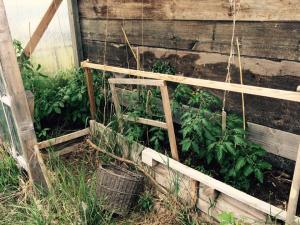



Shavuot - Jalda could explain much better the holiday at which we celebrate so much: The handing over of the Torah, Ruth's story, or rather her decision and commitment, the beginning of the harvest and the receipt of the first fruits and grain ... It is a happy feast, enjoyment of life, the beauty and the growth of nature. And so all of us were in the fields, weeding and watering, chattering or in silence - all according to our nature and mood.
After work we gathered at the raised strawberry bed and Jalda told us much about Shavuot, its meaning, its history and especially what Shavuot can tell us today. We thought of those who were missing and all those who could not come - especially Anna, Marlis and Etha. Many questions were asked and answered enthusiastically by Jalda .... of course also the first strawberry harvest was picked and enjoyed.
Then we sat together in the garden of Rita and Ulli in a large circle in beautiful weather.
There we enjoyed tasty packed lunch (naturally milky, sweet course ...) and Rita's great soup. Anja read from the book "The Triumph of Eve“ and at the very end, as unfortunately some had to go home already, Dvora gave a super exciting presentation on "Park Sanssouci and Kabbalah" - an essay in the context of her current studies in Potsdam.
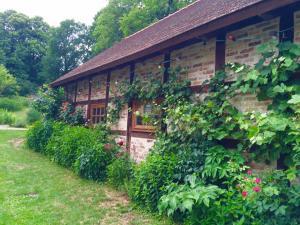

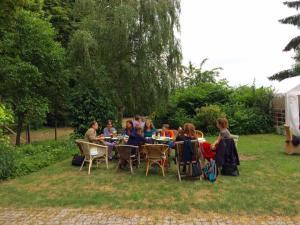


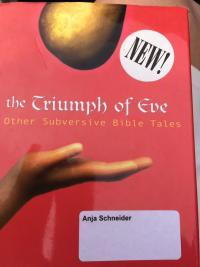
Yes of course, cleaning up and washing dishes also belonged to the tasks ... as in all families.
Text: Esther Trapp Photos: Romy Köcher
Translation: Etha Jimenez and Joseph Rebling
Planting Festival 2016
This year's planting ceremony took place on Sunday, May 8th, 2016/ 30th of Nissan 5776. It was also the 15th day of the Omer time and the 1st day of Rosh Chodesh Iyar. At this versatile holiday we had the ideal weather conditions for the season´s opening of our green shul: blue skies, sunshine, about 25 ° C and a refreshing wind. We were about ten enthusiastic Ohelistas who looked forward to digging the earth, to sowing and to watering, - and to watching the growth of our plants later on.
A few days earlier, Anna and Daniel had repaired the winter damages, so we could get started right away with the gardening. And there was another surprise: just before the planting festival, Anna had built a junior raised bed for those of us, for whom the other beds are too wide or too high. A big thanks to Anna and Daniel. It is a very touching side of Ohel as Chavurah that, handicapped members are given the opportunity to participate in all activities as good as possible. I am very grateful for that.

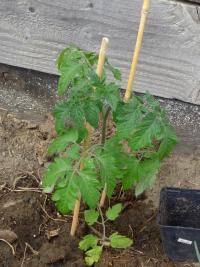



Even among our youngsters, there are already hard-working elves. Ben is one. He is becoming a competent all-around gardener more and more: planting, handling the water hose or generator and filling the water barrels. With his help, I could also help with the watering of the flower bed. Thank you, dear Ben.
And there was another big surprise: Ben was allowed to drive the tractor. Ulli had promised him that, when his arms and legs are long enough to use the tractor throttle, brake, gearshift and steering wheel, he is allowed to drive it on the field. Now it was time. For Ben certainly the biggest surprise and the highlight of the day. As expected, he steered the vehicle safely and prudently over the field. Others were infected by his enthusiasm and also drove a round. The tractor is a special model from the fifties and in good condition. So it was a great honor to drive it.


When we had finished sowing and watering, we went back to the carriage house. We sat there together on the grass in the light of a mild evening sun. Of course, we now were very hungry, and enjoyed Rita´s delicious vegetable soup and sumptuous strawberry cream cake. A fitting end to a promising start of the season on the field.
Our green shul opens our hearts to the wonders of nature and the presence of the upper worlds. It is a very great opportunity for us as a group and for each individual.
Text: Etha Jimenez Photos: Anna Adam
Translation: Etha Jimenez and Joseph Rebling
Passover 5776 – 2016
Around 7 o'clock in the evening the large, bright room filled slowly but steadily. The large table had been beautifully decorated by eager helpers. For the first time, we celebrated in a Nachbarschaftsheim in Herbartstraße. Many new and old friends were happy to meet again, and both large and small children explored carefully where there might be hidden corners to play and rollick around.


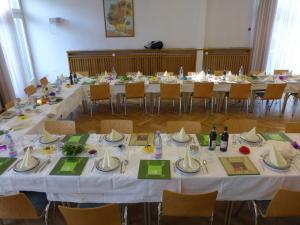
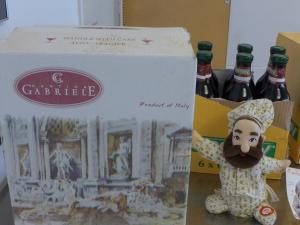
The Passover Seder brought the Ohel-family together.
Jalda, our cantor, took us by the hand and led us with joy, with lots of love, with songs and her beautiful voice through the Haggadah. Again and again she stopped her narrative to explain and establish connections between then and now. It cannot be taken for granted that today we can celebrate Passover in freedom and peace in this part of the world.




The banquet was overwhelming: Anna and her helpers have spent a lot of time and energy to conjure a dazzling menu and transport it to our festival site.
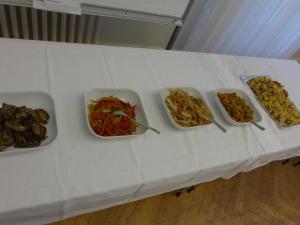

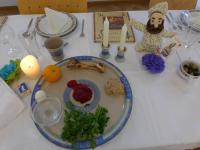


Many thanks also to all the other helpers, who effectively and calmly made sure that everything was prepared and decorated. A particularly strong praise goes to our "junior assistants", Jonas, Ben and the young Swarthouts - without them it would have been difficult to win the nightly cleanup Marathon!

What a blessing that Ohel Hachidusch is such a big family.
Text: Esther Trapp Photos: Anna Adam
Translation: Etha Jimenez and Joseph Rebling
December 5, 2015: Jonas Samuele is Bar Mitzvah
Jonas Samuele Lezzi became son of duty on a windy Shabbat morning of 23 Kislev of the year 5776 . He invited his large family and many friends, as well as the chevra Ohel Hachidusch into the prayer hall of the former Jewish orphanage.
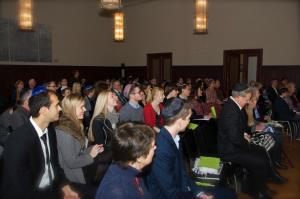
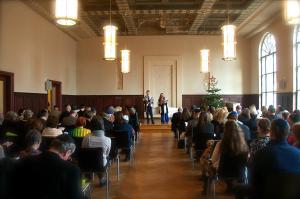
His guests immediately felt that this room breathes history and is a symbol of the continuation of Jewish roots in this area. Chasan Jalda Rebling led the congregation through the classic morning service of Shabbat. After the morning blessings, the song verses of Psukej de Zimra followed the morning Shema and the standing prayer, the Amida.
The family of our Bar Mitzvah Jonas Samuele was asked to come on the bima and in a moving ceremony the Torah scroll, dressed in a blue velvet mantle, was handed from the older generation to the youngest - l’ dor va’ dor.

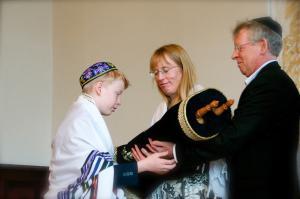
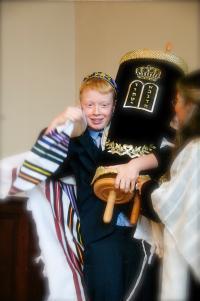
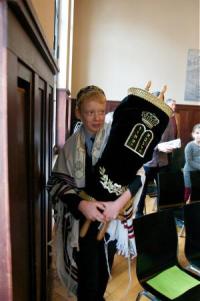

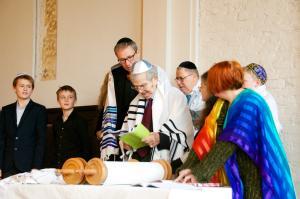
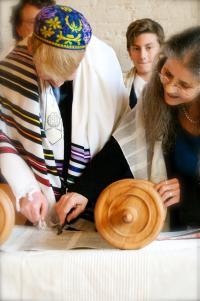

The year is still young and the Torah reading of Bereshit (in the beginning) 37.1 to 37.22; was a highlight of the service. For the first aliyah mother Eva was called. She could not completely hide her excitement at this unfamiliar and brave step. It was all the more touching to feel and learn, how the different generations hand something on along the way - in the name of G´d, who opens our ears and hearts. The second aliyah of the immediate family and the following aliyoth also reflected this idea. Jonas Samuele's call was eagerly awaited and his calmness and assurance mirrored the confidence of this Bar Mitzvah in the tradition of Judaism. Even as Jonas told the listening congregation his interpretation of the section on Joseph and his brothers, we were amazed by the wise words of a 13 year old.
Rewarded with a candy rain, Mazel Tov-calls and a small gift from the members of Ohel HaChidusch, we celebrated this special Shabbat Vayeshev with wine and bread.

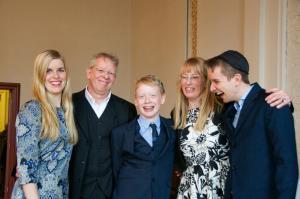

Text: Schulamit Froemmel
Photos: My-Linh, http://www.kunst-photography.com/1.html
Translation: Etha Jimenez and Joseph Rebling
October 30 and 31, 2015: Tehillim Workshop with Chazzan Jalda Rebling
The tunes of this Shabbaton will resonate in us for a long time.
In our Tehillim workshop we celebrated Kabbalat Shabbat, Shacharit and Mincha and discovered the Psalms anew. Center of our Shabbaton were the parashah Vayeira as well as the Shirat HaYam (Shemot 15) . Other Tehillim of the workshop were: Psalm 92 and 93, as well as Psalm 148 and Psalm 67.
The Talmud considers Shirat HaYam the first hymn (BT treatise Pesachim 117a). We sang this first song of the Torah and the other psalms as they were sung by the Levi'im millenniums ago in the Temple of Jerusalem, i.e. 2 choirs, sometimes three, who met in antiphonal singing and parted again. Especially in the Shirat HaYam, which was written by Prof. Amzallag in a chiastic form (i.e, X-structure of the verses) and was edited by Chazzan Jaclyn Chernett and Chazzan Jalda Rebling, this mode of chanting has developed a fascinating energy. The large hall echoed with antiphonal singing, long notes of one group and simultaneous syllable singing of the other group. A very old tune of the Red Sea-song, which was mediated by generations from mouth to ear and is known in different variants, sounded surprisingly modern in this way. The spiritual effect of these techniques was extraordinary. Our prayer came from deeper levels of consciousness.
I think, all of us felt that the singing of psalms in an ancient Jewish tradition can lead to a new approach to the old poetry. How celestial it must have sounded when the chants of thousands of Levi'ím in the Temple in Jerusalem resounded through the Judean desert. Chazzan Jalda Rebling has been studying this old performance practice of T'hillim, the Jewish psalms, for many years, and we are grateful that she has ushered us so expertly into this world.
Our special guest at this Shabbaton was Eva Sax-Bolder from New York, rabbinical student at ALEPH, who will obtain her smicha next January on the Ohala conference. She also is a graduate of Kol Zimra and student of Rabbi Shefa Gold, a pioneer in Jewish Chanting Meditation. In Mincha, at the end of the day, Eva has led us into the world of modern sacred chants. A large, but coherent jump over millennia. After Se'uda Schlischit, the third meal, this very special Shabbat came to an end with a very touching Havdalah lead by Chazzan Jalda.
Many thanks to Jalda and Eva for this profound spiritual experience and to Helen Eckstein for photos that reflect the atmosphere of the Havdalah so skillfully.

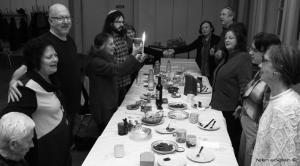

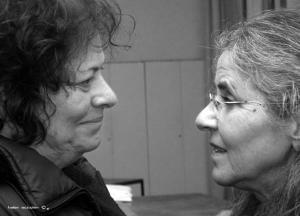

Text: Etha Jimenez Photos: Helen Eckstein
Translation: Etha Jimenez and Joseph Rebling
Sukkot 2015 - Erev Tishri 15,5776
More than 40 adults and children met in the afternoon before Erev Sukkot on the estate of Gatow to build our Sukkah and to celebrate together afterwards. As almost always at Jewish full moon festivals, there was good weather. As every year, our sukkah was made only from natural materials: wood, branches and plants that were left after the harvest in our green shul. All of us had a lot of fun pushing the plants with a cart from the field to our sukkah building site. In addition, the children made chestnut chains and other jewelry under Anna´s guidance.
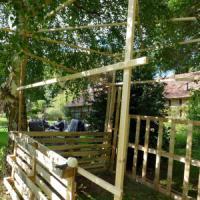

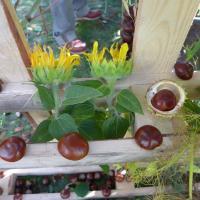
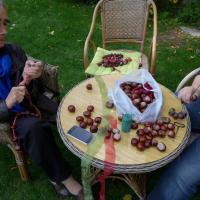
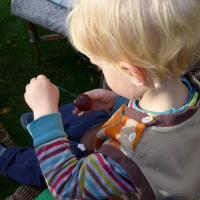

Soon our sukkah was done and the result could be seen.
Before Kiddush we went to "Mount Sinai" in Rita's Garden of World Religions. The children harvested grapes from the vines that Susanne had brought a few years ago and which had flourished so wonderfully under Rita´s loving care . Then the now three years old Jonathan reaped the Hokkaido pumpkin, which he had planted on Tu b`Schwat as seedling. Will he ever forget this moment of harvesting?


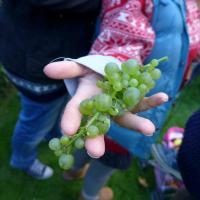
Dusk was falling. All huddled together in the sukkah as Cantor Jalda invited the 7 Ushpizin as well as other close relatives and friends who are no longer with us, and whom we are missing, into our sukkah. It was a very emotional moment when the thoughts of many of us wandered to the forefathers and into the desert while we looked through the loose branches of our cottage into the sky. Shulamit bentschte the candles and our lulav, she shook it symbolically. Of our lulav we were particularly proud, because the willow branches and the etrog were our own cultivation in Rita´s Botanicum. Anja had brought myrtle. For Sukkot 5777, we would like to reap the entire lulav from the Botanicum and our green shul. Should we not put together all parts of the lulav from our European harvest? Rabbi Jan Salzman of Vermont has given us an example.
Now it was time for Chasan Jalda to say the festival day Kiddush over the wine.

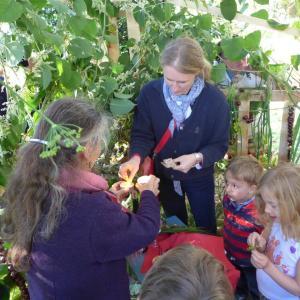

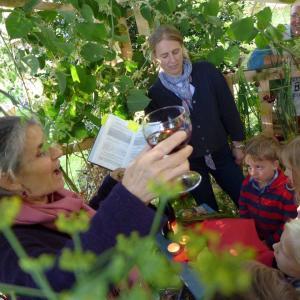
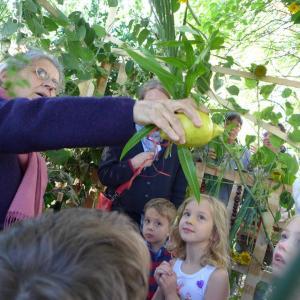

After that we met in the carriage house for our extended Kiddush. Meanwhile Rita and Marlis had managed to push the tables together in such a manner that all had space. It was cosy and comfortable . At the beginning of the Kiddush, Ulli played the Hatikva on his clarinet. This fitted well as a transition from our sukkah, the symbol of our wilderness wanderings, to modern Israel.
We celebrated, ate, sang and laughed. Firstly we relished the delicious vegetable soup that we had prepared over an open fire. Afterwards we enjoyed the delicacies of the buffet, to which all had contributed.
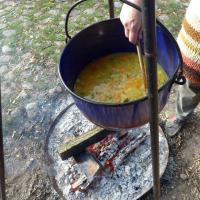
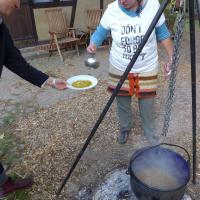

In the darkness we chanted together. It was a magical atmosphere, densified by the huge moon standing very low. Whoever went into the sukkah once more, saw his mysterious light shining horizontally through the airy branches of our sukkah.
Thanks to Chasan Jalda and Anna Adam, who so wisely led us into the desert and back again. It was an evening of living Judaism. And very special thanks go to Rita and Ulli Reinecke, who are celebrating such wonderful festivals with us on their farm.
Text: Etha Jimenez Photos: Anna Adam
Translation: Etha Jimenez and Joseph Rebling
Tashlikh in Gatow 2015
On the first day of Rosh Hashanah 5776, 25 adults and many children met in the carriage house of Gatow for Tashlikh.
At the beginning of our small ceremony we wrote all the things, that should no longer accompany us in the new year 5776 , on water-soluble paper.
Then we walked to the shore of Havel river.
Anna and Jonas blew the shofar on the shore of the river.
In a very touching and contemplative ceremony, led by Anja, we handed over the things which should no longer accompany us, to the river Havel in a very gentle manner. We put our water-soluble papers, on which we had written down all that bothers us, in small water -soluble bowls, previously decorated by us, and sent them on the journey.
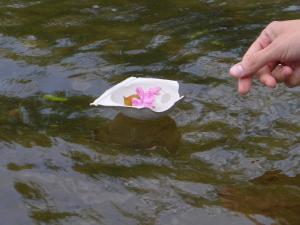
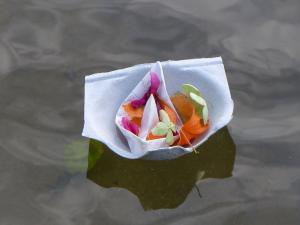

Then we went back to the carriage house. Delicious food expected us there to nourish us physically after all the "soul food" we received in our ritual at the river. Once more we experienced a very special and harmonious afternoon in Gatow.
Many thanks to Anja and Anna who led us through the ceremony and a large Thank you to Rita and Uli for their hospitality.
Text:Marlis Malkah Ventur Photos: Anna Adam
Translation: Etha Jimenez and Joseph Rebling
Shavuot 5775 / 2015
A minyan of our community meets for Shavuot and thus for “Tikkun Olam”, the Learning Night, in the remise in Gatow. Rita heated the large oven for us because it´s cold in here. Our cantor, - Jalda-, began to sing, and we warmed up immediately. Then, we all sang Psalm 122 together to a tune of Shlomo Carlebach.
Jalda reads the first two verses of the psalm, and we discuss their meanings.. They say: It is to be hoped that people meet each other in peace and goodness, - built on the desire to sanctify their reality and build a house for hashem. Jalda speaks of the law at Sinai and quotes from the Torah. The Israelites were sent to do and hear. Just do before they heard? They vow to keep the mitzvot, even before they had heard them for the first time. The mitzvot were always there and were given to be valid forever.
What could this sequence mean: first the doing, then listening? Does this mean that the Torah was given, and then everybody can know what is to be done? Only in doing good they listen to the words. We talk about it up to this day . But there is no peace in the world. Even among the first brothers Cain and Abel there is rivalry and envy ending in fratricide.
After the Torah was given at Sinai , plant sacrifices and animal sacrifices were offered together. Thanks to the Torah there is no more reason for greed and violence. After the escape from the confines of "Mi zar”, and - in the plural - from the narrow ,"Mizarim" that is Egypt, we are standing together at Mount Sinai. Every man for himself and all of us together receive the Torah... In Freedom, we accept the Torah.
At this point, we make a first study break. We go outside, breathe the fresh evening air, see the crescent moon and the planet Venus, in apparent tete a tete in the shimmering dark . We take a leisurely walk in the little garden of the World's Religions, Rita´s Botanicum. Some of us stayed in the Remise and thankfully set a festive table for all of us. Each had contributed something milky for our meal. But first, all of us enjoyed the barley soup, which was donated by Etha and prepared by Rita. This delicacy - mmhh tasty - must, as I am sure have been prepared after the ancient secret "Schit method" that went like this: "Mer schit in a pot a bissl dies und a bissl das and then mer... “!
Shavuot is the second harvest festival after Passover in the growing season. At Shavuot, there is really much to do in the fields and the cattle has born its calfs. Therefore, there is enough milk to feed the people as well as the young animals. This way the newborn cattle does not have to be slaughtered but can be raised. Unlike Passover there is not enough time at Shavuot to celebrate another eight days. And with Shavuot the 49 day period of counting the Omer which had started at Passover, is coming to an end. On the 50th day we receive the Thora at Sinai, which tells us how we can live in peace with each other as free people.
Jalda continues reading: The Israelites saw the thunder from the mountain... So it says in the Torah. Why doesn´t it say, they heard the thunder? We discuss this verse and come to the agreement that it could mean: The Israelites saw, i.e. they had an insight into the message that came to them from the mountain. This insight into the nature of the message goes without acoustic perception. It is an inner hearing. They listen. People with insight understand this "language". Shema Israel!
We hear from the Book of Ruth of Ruth´s gleaning of an already harvested field for a meal. We discuss the message of Ruth. She trusted in the One and acted accordingly. Confiding in Naomi , the person nearest to her and in loyalty to her, she left everything she knew behind her and was ready for completely new experiences.
We know that milky foods are a tradition of Shawuot and can now no longer resist the temptations of cream puffs and cheese cake prepared by Gaby and Rita.
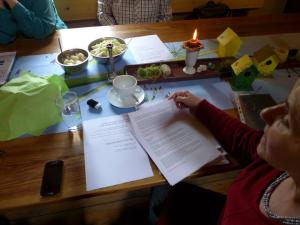
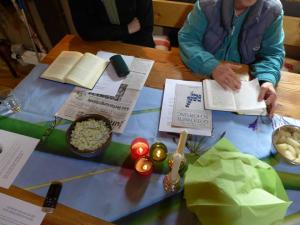

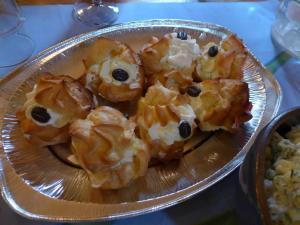
Our guest for this Learning Night is Dr. Ulrike Offenberg, a rabbinical student about to graduate. She has prepared a shiur. It deals with possible outcomes in situations of conflict. As examples, Dr. Offenberg is using the yeshivot of Schmaii and Hillel which existed about a generation before the destruction of the second temple. Using different text examples from the Talmuds, Tosefta and Mishna and others, we realized what happens when several opinions prevail and create dissent. Who is right? Both? Or just one? The school of Hillel? Why this one? Because as a rule it judged kindly and mild? Or is it that editors deliberately preferred them? If agreements can be reached apparently without effort, is this an idealized description of the situation? At the beginning of the dispute, did everyone wanted to enforce his will only? Even if that could result in a military conflict?
On this evening, we have the hope that in case of conflict good compromises can be found. The opinions of both yeshivot and further opinions were handed down to us. There is not one true and only opinion. Thus, the intellectual circle to the Psalm responsible for peace, because at Sinai the commandments were given to us to act accordingly. The commandments are no longer in the heavens, as the Midrash, which Ulrike told us at the end of her shiur, illustrates. We close our Learning Night by singing Psalm 122 once again. Tired, but nourished in body and soul, we look forward to sunrise and Shakharit.


Text: Dvora Williger Photos: Anna Adam
Translation: Etha Jimenez and Joseph Rebling
May 10, 2015: Planting Day in our green shul
There was a chill breeze blowing through the fields of Gutshof Gatow on the Sunday afternoon when the Ohelistas gathered for their annual planting day. Toddlers, teenagers, and adults braved the winds to put seeds and starter plants in the ground and in the raised beds that the congregation built last year. With a little help from some sunshine and rain, we will soon have onions, beets, pumpkins, lettuce, zucchini, carrots, and other vegetables, as well as various herbs and flowers to enjoy.
The many helping hands made the planting and watering go quickly so that after only two hours we could all go inside and warm up with some hot soup and other treats. Just as we had finished our refreshments and were ready to head home, the clouds burned off and the sun shone bright and strong. It was a good omen for the new growing season.
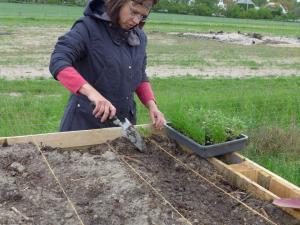

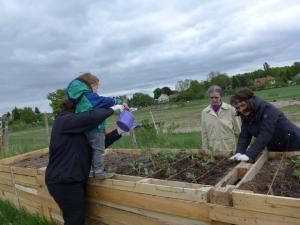





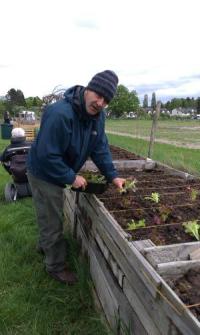

Text: Donna Swarthout Photos: Anna Adam and Donna Swarthout
Our Seder on April 4, 2015:
Passover is the festival of liberation from Mitzrayim, from the confines of the slavery and from personal narrowness.
But Passover is also the Jewish family celebration par excellence. Most adults get bright eyes when they talk about the Passover celebrations of their childhood.
At our Sedertable sat 40 people, including ten children and many guests who also came the years before. Immediately after entering the room, some of the children asked for our "game blanket" and enjoyed the familiar and new toys.
As last year, we used the beautifully illustrated Haggadah by Michael Shire et al. with transliteration. The illustrations are facsimile reproductions of medieval manuscripts of Ashkenazi and Sephardic origin from the collection of the British Library in London.


As usual, Cantor Jalda led the reading of the Haggadah with heart and commitment. Almost everybody participated actively in the readings and was moved by the ritual which in its oldest parts is more than two thousand years old.
During the readings some of the children were crawling around under the long tables. Some of us who still knew Lilith z"ll, looked at each other. And at once we shared the same memory: how happy Lilith was, when she told us of the Seders in her Viennese childhood ,when she crawled around under the table with her numerous cousins. This memory of another era has survived many decades.
Anna and her cooking team gave their best. And their best really is the best there is: everything organic, everything homemade. And Anna is not only an artist when dealing with paints, paper and wood, but also in the kitchen. Especially in the use of exotic spices she is an expert.


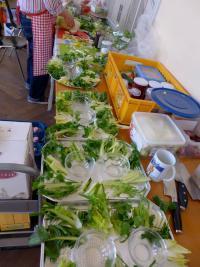
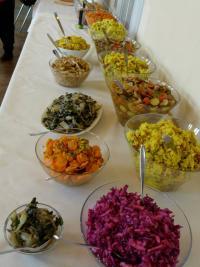
The afikoman was hidden cleverly. Only after a long search Jacob found it, and we were able to close this festive evening with traditional songs. Naturally Jacob was very proud of his success and he, as well as all other children, got his gift. Somewhat overexcited and exhausted, but very happy, they went home.


We owe a really special end to our Seder festivity to Helen. She drove well after midnight with the leftover food to the Stadtmission at Bahnhof Zoo and told the homeless gathered there in a few words the meaning of Passover: a festival which represents freedom. Then they all ate together. Helens guests were naturally thrilled by Annas cookery. But in addition they were impressed by Helen´s personal gesture to celebrate with them.
This is part of the spirit of Passover, because it says at the beginning of the Passover Haggadah:
"All who suffer shortage, come and celebrate with us ....."
So we had the opportunity to conclude our Seder with Chesed and a contribution to Tikkun Olam.
A big thank-you to all who have helped us in the preparation and implementation of this festive evening.
Text: Etha Jimenez Photos: Anna Adam Translation: Etha Jimenez and Joseph Rebling
Purim 2015
Members of Ohel Hachidusch gathered to celebrate Purim with loads of sweet and savory hamentaschen, freshly baked by our little and grown-up experts, happy and rowdy children dressed as pirates and fairies, and Jona Kirchner´s science fiction spin on the Megillah. Cantor Jalda led us in song, the kids enthusiastically shook their noisemakers, and even the adults got into the action. We ended the celebration in traditional Ohel style with a hearty and healthy vegetarian potluck, which we enjoyed with good conversation and lots of laughter around our community table.
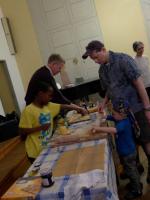




Text: Donna Swarthout Photos: Anna Adam
January 24, 2015: Noa is Bat Mitzvah
On 4th of Shevat 5775 , Shabbat Bo, Noa was called to read the Torah for the first time and hereby was accepted into the circle of adults . She read on this Shabbat Mincha the Parasha Beshallach, because Mincha Shabbat we already read the Parasha of the new week.
It was an impressive celebration. Again, as at Mathilda´s Bat Mitzvah, there were three generations standing together on the bimah. Sawta Gaby, ima Mira and Bat Mitzvah Noa read together from the Torah . It was a very touching moment when l´dor va dor - from generation to generation - the Torah was passed on. For the first time, Noa was wearing the tallit which her mother had sewn by hand for her. Before the beginning of Shabbat, Cantor Jalda and Anna, the chairwoman of Ohel Hachidusch, jointly tied the Tziziot with Mira and included many good wishes for the future of Noah therein.
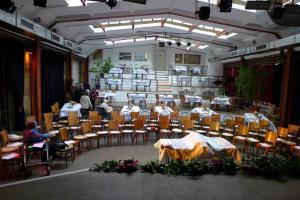

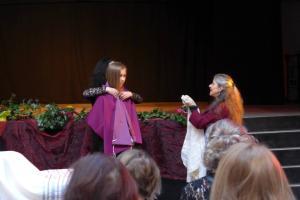

As always, Cantor Jalda led us skilfully and empathically through the ceremony and Anja read the millennia-old Shirat Hajam so touchingly that we all stood at the Red Sea.
As Cantor Jalda gave Noa her blessing, you could have heard a pin drop. Even the numerous children realized that this was a very special moment and sat quiet as a mouse. And then there were big cheers all around. Noa has become Bat Mitzvah and was celebrated tumultuously with a rain of sweets.

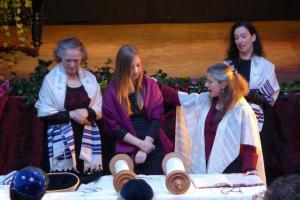
The subsequent Havdalah was marked by our feeling of togetherness. We all stood in a circle, and in a moving ceremony Cantor Jalda took us back into everyday life. Shawuah tov!
And in no time at all our room in the restaurant La Luz was transformed: - all were sitting now at nicely decorated tables, the big stage was free -. Noa´s justly proud father gave a speech in honor of his daughter, a screen was curled up on the big stage, and many snapshots of Noa's life were shown. An Israeli DJ took over the stage; first with songs that Noa's grandmother Gaby had wanted and many sang along. And then it was getting rockier and more colorful. Many danced merrily, - including the children and the elderly. For the Hora hardly anyone stayed sitting on the chairs. Even a few months old baby (on the arm of the mummy) and the nearly 90-year-old Gerhard joined in. Here danced Am Israel, which had crossed the Red Sea and began a life of freedom. -The atmosphere and Noa´s parasha matched perfectly.
Even desert children are hungry. -Our manna was provided by Noa´s sawta Gaby. Meanwhile, coffee and delicious cakes had already been brought to the tables, of course, all baked by Gaby herself. Soon they were followed by a sumptuous hot and cold buffet, everything cooked by Gaby. The Jewish Berlin has known and appreciated Gaby's cooking for years, but here she has exceeded herself. How she managed to take care of so many guests as relaxed and competent as she was, remains a mystery. But it has definitely something to do with her love for Noa. For Noa she once again has outgrown herself. It was a masterpiece and her way of showing her affection.
Dear Gaby and dear Mira, thank you for this unforgettable festival and you, dear Noa, mazel tov for your future. You are a great mischpacha.
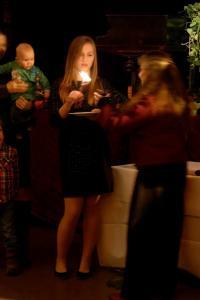
Text: Etha Jimenez Photos: Anna Adam
Translation: Etha Jimenez and Joseph Rebling
November 16, 2014: Mitzvah Day at Ohel Hachidusch
For Mitzvah Day Ohel Hachidusch hosted a workshop in Gutshof Gatow on a not too well known ecolological problem: contaminated birdfood. Parents and children of the neighborhood were invited to join us.
We prepared birdfood for the feathered and singing creatures who in our latitudes have many problems to find sufficient nourishment in frosty winters. But this was not the only reason for our engagement: while studying the topic more intensively, we had noticed that in some commercial birdfoods, industrial mineral oils and industrial wastes are utilized. Likewise, with the seeds in this inferior birdfood new plant species - i.e. Ambrosia - reach Germany which may do great damage to domestic plants, animals and also humans. No sooner said than done: in the warm carriage house of Gutshof Gatow we heated palm oil in a small pan and added ecologically valuable seeds and grains. We let the mixture cool down and stuffed it in opened pine cones .
The Mitzvah Day ended with warm faces and hearts and around 50 ecologically valuable stuffed pine cones. To the delight of the children, we hung some of the cones on trees and balconies. The birds love them. And pretty soon we will have to prepare a fresh supply. Some families already asked for the recipe and made their own birdfood. Mission accomplished!
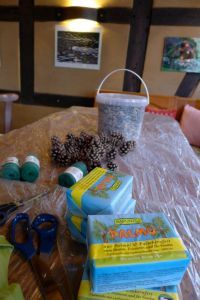


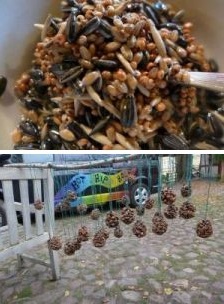
Text: Claudia Shulamit Frömmel Photos: Anna Adam
Translation: Etha Jimenez and Joseph Rebling
Saturday, November 15, 2014/ 22nd of Cheshvan 5775
Shabbat Chaje Sara:
Bejt HaChidusch visits Ohel HaChidusch
For many years now it is a great pleasure for me to visit Bejt HaChidusch in Uilenburgshul in Amsterdam / Netherlands. A few steps away my mother was born more than a hundred years ago. Sometimes I lead services or workshops there; sometimes I just join for Shabbat services when I am in Amsterdam. Rabbi Hannah Nathans, whom I already knew from the Aleph seminar, had the idea to come to Berlin with one of her groups to visit Ohel HaChidusch. Many members of our small community participated in the organization: Sue reserved hotels, Channah took care of the booking of restaurants. Angela, Channah, Helen and Anna hosted those members of the group, who preferred private accommodation.
Rabbi Hannah Nathans and myself prepared an extensive program:
Kabbalat Shabbat in Fasanenstrasse; Shabbat at Ohel HaChidusch in Detmolder Strasse; Sunday at Centrum Judaicum and a guided tour through Berlin´s historical center and finally a visit to the Jewish Museum Berlin.
One highlight of the visit was the Shabbat at Ohel HaChidusch. Following a very moving Shakharit service, there was a lively exchange of experiences during kiddush. Later on, rabbi Hannah gave a shiur on the subject: " Is animal research allowed? What does our tradition say?" We studied rabbinical and scientific texts followed by an exciting discussion afterwards. After a coffee break, I gave a shiur on the subject: "Tora of the Imahot". In the context of parashah Chaje Sarah we had an intensive, sometimes quite controversial discussion.
After Havdalah all of us were grateful and glad about this meeting. We studied together and learned from each other, ate well and all of us expressed the desire to repeat such meetings, whether in Amsterdam or Berlin.




On Sunday I met the group in front of the Centrum Judaicum and gave a very personal tour of the center of Berlin with old and new stories from this area.
Thank you, Reb Hannah, for this beautiful idea. Come back soon to Berlin. You are always welcome to join us. The experience with you and Bejt HaChidusch means a lot to us.
Your very personal thank-you note to all of us has been particularly touching, which is why I include it here:
Shalom Jalda and Ohelista’s,
On behalf of our whole group I would like to thank you whith all my heart for your hospitality. It was a great experience for our participants. You made it possible that the whole group could come along by offering your beds. The food was excellent, and eco kosher. The restaurants you reserved for us were just right. The group was greatly impressed by your service, and does hope we can have more of this in BHC. The shiur by Jalda on the Torah of the imahot was found very interesting. The tour through Jewish Berlin, guided by Jalda, left an indelible impression. It was a most wonderful weekend.
I realise how much work this has been for you. Toda raba for everything!!!! And rav berachot on your kehilla. We hope to meet again soon!
Lehitraot, Rabbi Hannah
Text: Chasan Jalda Rebling Photos: Anna Adam
Translation: Etha Jimenez and Joseph Rebling
Sukkot 5775
The afternoon before the 14th of Tischri 5775, Erev Sukkot, we met to build our Sukkah at Gutshof Gatow.
Like every year, parents and children built the sukkah, under expert guidance of Anna.
At the same time, a second group of us went on our field with a handcart to reap the fruits of last season.The children came back with abundant harvest, enough to decorate the sukkah and to prepare the Sukkot festival soup.
On the farm the sukkah was decorated and completed while the freshly harvested vegetables from many busy helpers were washed, cleaned and prepared for our soup.
Then Rita sparked the fire. Now the soup could cook.
Every year on Tu B'Shvat our children are planting pumpkin seeds from last year's harvest in a flower pot. Some months later at Sukkot the pumpkin is harvested in the Botanicum by our children.
After all extensive preparations it was time for Kiddush.
And every year exactly at this moment it starts raining. Our Sukkot-prayers for rain are fulfilled on the spot. So we are happy and grateful about it. But since we want to stay healthy, we moved to celebrate in the cozy carriage house. There we enjoyed the delicious, freshly cooked soup and all the culinary delights brought along.
It was, as always, the most beautiful sukkah we've ever had.
Thanks to the great hospitality of Rita and Uli we celebrated an unforgettable, turbulent and happy Sukkot with about 50 adults and children.
Later in the evening the sky ripped open and we admired the big full moon shining into our sukkah.
During the following days of Sukkot week, some of us went to Gatow with friends to sit in the sukkah and remember Am Israel wandering in the desert thousands of years ago and up to today.
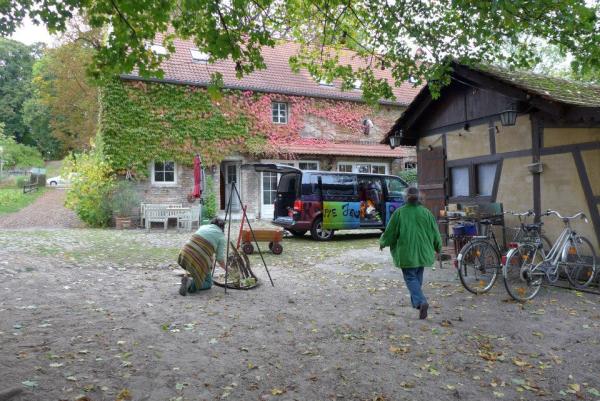
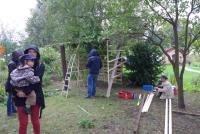
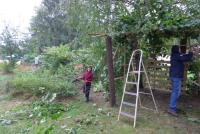
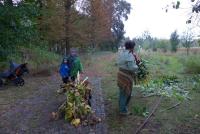
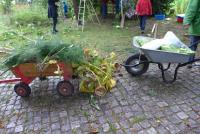
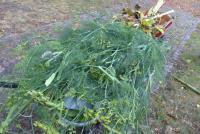


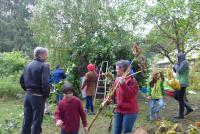
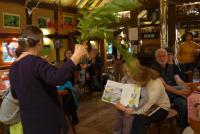
Text: Marlis Ventur Photos: Anna Adam
Translation: Etha Jimenez and Joseph Rebling
August 17, 2014: Our Zalman - Fest

Sunday, August 17, 2014 / 21st of Av 5774 we celebrated our “Zalman-Fest” for Reb Zalman Schachter – Shalomi z”l. This day would have been his 90th birthday. He passed away some weeks earlier . Therefore our birthday celebration turned into a Learning Festival in our green shul in Gatow, just the way he would have liked it. He was and will be our Rebbe and our teacher
and accompanied our tent (ohel) from its very beginnings with much affection and love. Chasan Jalda held a shiur about a text in one of his recent books: “Wrapped in a Holy Flame: Teachings and Tales of the Hasidic Masters”. Some of us shared thoughts which they associate with Reb Zalman. Our rabbi Zalman Schachter-Shalomi is the founder of Jewish Renewal, and Ohel Hachidusch arose out of Jewish Renewal. Reb Zalman and his chaver Shlomo Carlebach contributed so many new and renewed old texts to modern Jewish liturgy. Touching chassidic melodies and nigunim were adopted by the whole Jewish world via Jewish Renewal (you may download some on www.neohasid.org ). We sang some of them on our festival and learned„V´taher Libeinu – Clean our Heart“. It is a song concerned with T´shuvah, appropriate for the upcoming High Holidays and blending well with the text selected by Chasan Jalda for her shiur.
And, of course, there was much more singing, a bonfire in honor of Reb Zalman and a vegetarian potluck picknick.

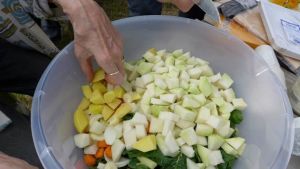




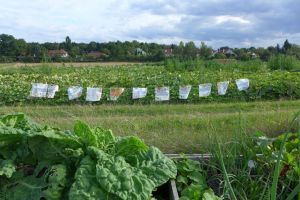

We are sure that Reb Zalman will continue to accompany and inspire our learning and growth
Text: Etha Jimenez Photos: Anna Adam
We thank Joseph Rebling for looking over the translation.
June 28, 2014: Welcome as our new Bat Mitzvah, dear Mathilda
On June 28, 2014/ 30th of Sivan 5774/ Shabbat Chukat/ Rosh Chodesh Tammuz Mathilda S. was called to read from the Torah for the first time. Just as with Avery´s and Sophie´s Bar/Bat Mitzvah, we celebrated in the historical prayer hall of the former Jewish orphanage in Berlin-Pankow.
The orphanage was founded in 1882 and closed in 1940 by the Nazis. Some children could be saved by bringing them to Holland and England, but many were deported into the concentration camps.
During the time of the GDR (German Democratic Republic), the historical building housed the embassies of Poland and Cuba, among others. 1999 the premises were purchased by the Cajewitz-Foundation and completely renovated. The place in the wall where the shrine for the Torah scrolls was located was kept open and undone by purpose. During renovation, the painted stucco cassette ceiling was rediscovered and exposed. Part of it was damaged. This also was left the way it was for symbolic reasons. (www.juedisches-waisenhaus-pankow.de)
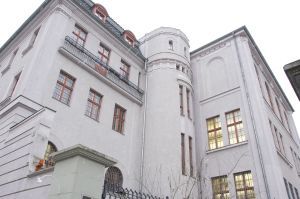

Photos: My-Linh, http://www.kunst-photography.com/1.html
Today the building is accommodating several institutions, among others a private school and the Janusz-Korczak-Library. And with Ohel Hachidusch active Jewish life moved into this historical place.
Three generations were united for Mathilda´s Bat Mitzvah: Her grandparents came from the United States. Parents, aunts and uncles came from all over the world. And besides cousins, further relatives, friends and members of Ohel Hachidusch, Mathilda´s class mates filled the seats. The big hall was just about filled, the atmosphere sizzling with youth´s positive energy. What great symbolism for young Jewish life in Berlin! Cantor Jalda Rebling lead us surely and warm-heartedly as usual through the liturgy. If a touch of stage fright might have been lingering around, it disappeared rapidly under her guidance. It was an emotionally very touching moment when Mathilda was given a hand-made tallit by her godmother. She had crafted this tallit out of fabric which still originated from the manufacture of fine table linen of Mathilda´s greatgrandparents in Berlin´s Rosenstrasse. The family could rescue it into the United States during their flight from Nazi-Germany. Now, in the fourth generation,,this special fabric is breathing new life. Certainly Mathilda´s godmother has stitched many good wishes and memories into the tallit. And on the eve of the Bat Mitzvah, Mathilda´s family, Cantor Jalda Rebling and Anna Adam, the chairwoman of Ohel Hachidusch, sat together and knotted the zizit. Each knot embodies many blessings for Mathilda´s future.






Photos: My-Linh, http://www.kunst-photography.com/1.html
Mathilda read her parashah fluently and beautifully. When the 3 generations were called to Torah altogether, special energy and emotion filled the room. Since thousands of years – le dor va dor - the Torah is holding together Jews all over the world and through countless generations.
All of us were eager to listen to Mathilda´s derashah. Mathilda summarizes it this way:
"In my speech, I mostly talked about the character of Miriam and the symbolism of the letters of her name that re-establish her character. Her name consists of the letters mem, resh, jud, and mem. The letter mem connects her to majim (water), since she provides the Israelites with it. Being the source of it, she is also the source of the torah, peace and life. The second letter resh, which has the numerical value of 200 stands for balance. Miriam is the balance in the way that she consists of the resh, swimming in water. If the water is gone, evil remains, but with both together there is balance. The third letter, jud, stands for the rock of the universe or the little drop from which every thing evolves. It also stands for her responsibility to keep the balance intact. If we all contribute to balancing the world in small ways, it will be a better place for all of us. "
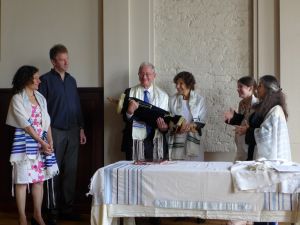
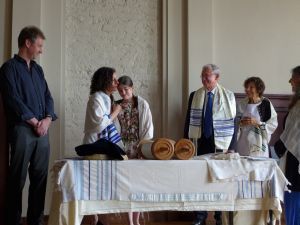

Le dor va dor... Photos: Anna Adam
At the end of the celebration, Mathilda´s overjoyed grandmother brought it to the point: "I am full of joy and happiness."
Dear Mathilda, Ohel Hachidusch is wishing you mazel tov on your further path of life.
Text and translation: Etha Jimenez
Many thanks to Joseph Rebling for looking over the translation.
Ohel HaChidusch and our wimpl as guests in Erfurt
On May 11th, 2014 six Ohelistas (Chasan Jalda, Anna, Anja, Jona, Claudia and Marlis) were travelling in the Happy Hippie Jew Bus to Erfurt.
With us traveled our Torah, supported by a modern Torawimpl sewn by ourselves.
The occasion of our trip was the special exhibition "Rudolstädter Judaica. Synagogue textiles of the 18th century "in the meeting place "Kleine Synagoge Erfurt".
In a Shabbat Minkha service under the guidance of Chasan Jalda Rebling, the Erfurter Jewish Community and their guests could experience what a Torawimpl is for and how it is used.
The service was a women´s minjan. The gentlemen were invited to be present on the gallery.
The Minkha service was very well attended by the Erfurters. Many experienced for the first time how women lead a Jewish service and read from the Torah.
After Minkha, we showed our modern wimpl to those present and explained its history. Then we had very interesting conversations with the participants.
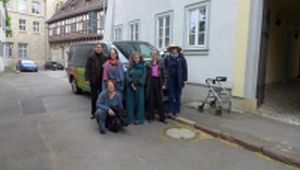

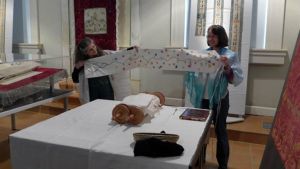

In the exhibition we saw beautiful and valuable Toramantls, Bima covers, Shabbes doilies and Wimpl. It was fascinating how well preserved these 18th century exhibits were.
In the meeting place we also had the chance to visit a 19th century mikvah right on the river Gera. It is no longer used.
Then we went through the Old Town of Erfurt to the Old Synagogue. There the museum director Ines Beese awaited us. She invited us to a special tour.
The Old Synagogue Erfurt, with its oldest parts from the 11th century, is the oldest synagogue in Central Europe which was preserved up to under the roof. The Old Synagogue was converted in a warehouse after the pogrom of 1349 and restored only at the beginning of the 21st century.
Our tour began on the west facade of the building, which was built around 1270.
Then we proceeded to the ground floor of the house. Here we entered the preserved large prayer hall. The sites of the Bima and the Torah shrine were indicated by light installations.
For me it was a wonderful experience to stand in a place where Jews 700 years ago prayed the Shema Israel, just as we do today. I spontaneously thought of the verse "L`dor va-dor nagid god`lecha ul'netzach n'tzachim kedushat'cha nak`'dish". - "from generation to generation we will proclaim your magnitude and declare your holiness eternally".
It was a very emotional experience to feel that we are members of an infinitely long chain.
In the next room we visited the "Erfurt gold treasure", which had probably been hidden by
a Jewish citizen of Erfurt during the pogrom of 1349. This treasure consisted of coins, tableware and jewelry.
Each piece was worth seeing. The centrepiece of the treasure was a beautiful and very precious wedding ring.
At the end of the tour we saw a fascinating Hebrew manuscript collection. This is the real treasure of Erfurt. We studied the texts.
After this highly interesting tour, for which we would like to thank everybody involved once again, we stopped by at a pretty little cafe in the old town. Invigorated and full of beautiful impressions, we drove back to Berlin in the evening.
Many thanks to Anna and Jalda, who made this inspiring day possible and brought us safely there and back.
Text: Marlis Malkah Ventur Photos: Anna Adam
Translation: Etha Jimenez and Joseph Rebling
Passover 2014
"Das Beste am Feste sind die Gäste!"
( The best part of a celebration are its guests).
As every year, Ohel Hachidusch took this advice to heart. We invited many guests from all over the world to join us for an extended Passover Seder 5774 (2014 c.e.). Everybody was in their best mood; and Cantor Jalda Rebling led us through the Haggadah, sometimes cheerfully, sometimes meditatively , sometimes pensively. Even the youngest ones were well prepared. With Ma Niishtanah they cast a spell on everybody and drove tears of emotion into many eyes. We felt assured that as long as we are celebrating Passover and tell about the exodus from Egypt in the traditional manner adopted to modern times Yiddishkeit will be carried on.
After mazzeman aced with Dajenu - this time he committed the mistake himself -, it was time to start enjoying an excellent, delicious and ecologically correct buffet. At 1 - 13 Mi jodea sooner or later everybody combined the text with the appropriate gestures. The Fourth Cup finished us off.
Conclusion: Next year in "Berlin" - although the sung melody sounded much more like Le shanah ha ba´a ba yerushalayim. Well, nostalgia belongs to Passover.
We thank the Kasher- and Cooking-Team for all the troubles of preparation.
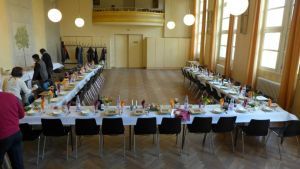

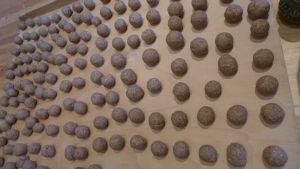
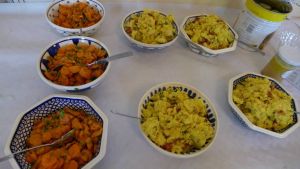

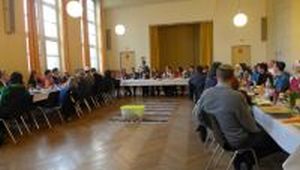

Text: Claudia Shulamit Frömmel Fotos: Anna Adam
Translation: Etha Jimenez and Joseph Rebling
Tu b´Shevat 2014 and our Planting Festival
Saturday, February 15, 2014/ 15th of Adar I 5774
Shabbat Tissa
Se´uda Shlishit, Havdalah and Our Planting Festival in Gatow
This year we will celebrate a belated Tu B`Shevat in Gatow. Cantor Jalda Rebling tells you why:
In Mishnah Rosh haShanah we learn about 4 New Year Days:
1st of Nisan,
1st of Elul,
1st of Tishri (according to Shammai) or rather
15th of Shevat (according to Hillel)
The Jewish calendar is based upon moon cycles. But our festivals go by the cycles of nature. Therefore we have to rebalance lunar and solar years from time to time.
Hillel II (4th century C.E.) defined 7 leap years in 19 years. Up to now we hold on to this system.
The year 5774 is such a leap year. We will have a 2nd month of Adar.
Just as Chanukkah coincided with Thanksgiving, so is Tu B´Shevat very early this year. Too early for planting in our degree of latitude. Our plant expert Rita thinks that such an early date for planting would make it very difficult for our plants to survive. Therefore, she suggested that we might introduce a planting festival at full moon of Adar I exactly 4 weeks later than Tu B´Shevat.. On behalf of our plants we liked this idea very much.
February 15 -that correspond to 15th of Adar I – is full moon, a good time for planting.
Therefore, we decided to celebrate a planting festival in Gatow after minkhah service and havdalah to put our first seedlings into flower pots.
t is not unusual in our tradition to celebrate festivals at a later date when they could not be commemorated at the proper time.
The maccabees celebrated sukkot at chanukkah and pessakh sheni is a possibility to catch up on pessakh.
As is written in the Torah in Bamidbar 9:1-14.
Cantor Jalda Rebling
This is the reason why we met February 15, 2014 for a belated Tu b´shevat and Planting Festival. We were lucky; weather was mild and our decision correct. We enjoyed a rich 3rd meal in the warm-hearted atmosphere of Gutshof Gatow. After Ben discovered 3 stars in the clear sky, we bid farewell to Shabbat with a beautiful havdalah celebration under the guidance of Cantor Jalda. Before daily routine got hold of us, we started our joyful planting festival. By now, our children are planting experts and concentrated on their job. Up to now, all plants are thriving.
We concluded this copious day with a visit of the talking birch tree behind the Gutshof. If we listen very close, sometimes in spring we are able to hear how the lifeblood of mother earth is upwelling into the branches of the birch.
This is green shul at its best. Our children experience the cyclic festivals of Judaism in nature and know very well, how many miracles have to happen every day until they can enjoy their pumpkin soup.

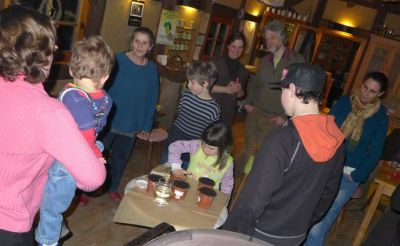

Photos: Anna Adam
November 24, 2013: We handicraft our own Channukah Candles
Once again Anna had a lovely idea: a Sunday afternoon workshop for children and adults in Gutshof Gatow where we made our own Channukah candles under her guidance.

For refreshment Gutshof Gatow offered homemade vegetable soup and cakes.
Some of us combined the workshop with a little walk through Gatow´s country side, visiting our field and fruit-trees. We went home in pleasant anticipation of chanukkah. Many thanks to Anna and our hosts Rita and Ulli for making this special afternoon possible.

Text: Etha Jimenez Photos: Anna Adam
November 17, 2013: Mitzvah Day in Germany
Global Day of Jewish Learning
Creating Together: Jewish Approaches to Creativity and Collaboration
On Mitzvah Day Jewish groups all over the world commit themselves to contribute to
Tikkun Olam – Healing of the World
G´milut Chassadim - Acts of Kindness
Tsedek – Justice, Charity
Ohel Hachidusch invited to a great get-together:
We brought mothers and children of different religious background to Gatow for a very special day in nature. Our guests have little money and wouldn't be able to afford a holiday in Gatow on their own. We picked them up at home with the Happy Hippie Jew Bus, which was stuffed with materials for handicraft work, games and books.
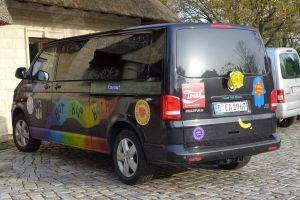

After our arrival in Gatow, we started out with a tasty breakfast followeded by a variety of programs: a walk through Gatow´s fascinating countryside, a visit to the Bockwindmühle, bake bread and cake in Gatow´s clay oven, bake potatoes in a bonfire, harvest vegetables, read fairy tales, do handicrafts. In the evening, we gave our guests a ride back home again.
All of us were happy. A little girl brought it to the point by saying: "This was the happiest day in my life." Be assured, little E., we´ll invite you again.
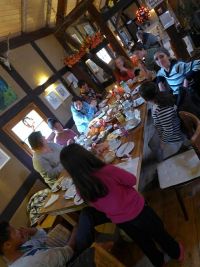
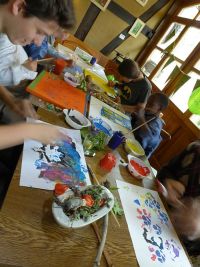
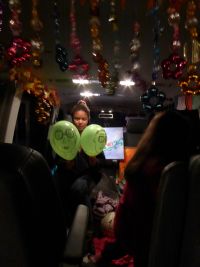
And God said: 'Let the earth put forth grass, herb yielding seed, and fruit-tree bearing fruit after its kind, wherein is the seed thereof, upon the earth.' And it was so. (Bereschit 1:11, JPS)
We felt this miracle on our field in Gatow and want to share our experience with others, care for each other, enjoy the beauties of nature together and thank her for everything she produces.
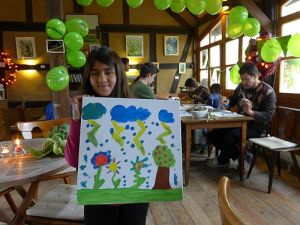


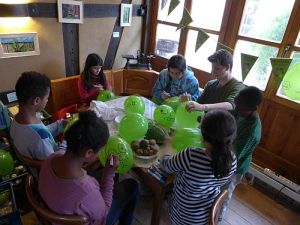
Text: Cantor Jalda Rebling Photos: Anna Adam
May 26, 2013: A Philosopher Introduces Her New Book
Dr. Jona Kirchner's new book titled, “Die Summe der Eins ist Dreizehn. Eine Einführung in die Symbolik der Hebräischen Bibel” (1) is an introduction to the symbolism of the Bible.
An excellent book and a wonderful lecture. In a quiet, sensitive almost gentle, unpretentious manner, Jona unfolds the relationship of letters, numbers and their value and importance to the Hebrew alphabet and text of the Bible. Modestly, with wit and humor, she invites the small group of interested listeners into her intellectual world. The skill of this philosopher is revealed in her seemingly effortless handling of creative thought and chains of ideas based on her solid foundation of knowledge. She has an unmistakable ability to establish connections to the “here and now” in a cheerful manner. There is no educational finger-wagging, no moralizing speech. She rather familiarizes us with the general context, than put herself in the foreground.
Her presentation was structured, very clear, to understand, even for non-rabbis and people like you and me – she leads us competently through the core texts of the Scriptures. In no place does she give the visitors of this lecture a feeling of the hardships, studies and reflections necessary to write such a book, nor of her inner conflicts to come to a comprehension of this world.
Competently, she led us through the core text of the scriptures. At no point does she allow the audience to experience the amount of study and reflection involved in writing such a book, especially of the author's understanding of the world attained through isolated self reflection of a philosopher.
Directed towards her listeners, she attained an atmosphere of partnership. Jona provided us with an insight into the free world of thought. However I wished other rabbis would have been present. Here we had a philosopher among us whose capability to draw on Jewish philosophy was an exemplary model. What she had told us was both fascinating, inspiring and brought great joy.
We the congregation, wish you dear Jona, a lot of success, luck and a fast track to a wide, new audience to your very worthwhile book.
Thank you.
Channah S. Arendt
Many thanks to Sharon and Sophie Kuckuck for editing the English version of this text.
[1]
[1] Jona Kirchner: Die Summe der Eins ist Dreizehn.
Eine Einführung in die Symbolik der Hebräischen Bibel. München (Grin VL)
2012, ISBN 978-3-656-28943-2
May 5, 2013: Planting Day in Gatow
Having just arrived in Berlin from the Norwegian winter, Gatow's
remise, Sunday the 5.May felt almost like the most beautiful place on
earth. The sun, the warmth, the flowers, the trees, the colors, the
smells, the sound of birds but most of all the people. One by one the
Ohelistas arrived and we moved to our field – pulling a cart with
the young trees Anna had bought. Rita followed with all the
planting tools in her car .
As always we took a picture of the Ohel family, after which Rita told
us a lot of interesting and useful information about the
field and all that might be growing in it. It´s the third year
we've been planting this field which had just been freshly ploughed by
Ulli. This year our potatoes will be planted in the center of the field
and we will grow several species of outdoor tomatoes. As a special
highlight we plan next weekend under Anna's competent guidance to build
a raised bed for flowers, herbs and vegetables at the end of field, so
that everybody who cannot bend easily can now join us comfortably in
seeding and harvesting,
Rita had collected quite a lot of seeds and gave everybody a handful
of, „ insect buffet.“ First, the blessing
„Sheheheyanu“ was recited and then we gently sowed
our seeds in the earth.
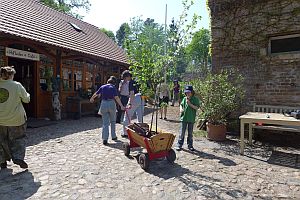

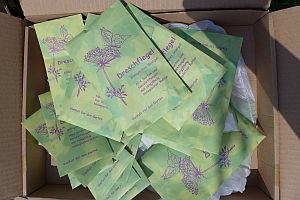
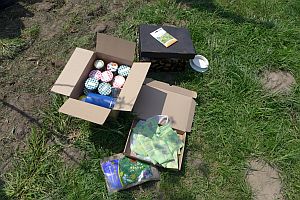


Now we were
ready to plant the 6 new fruit trees sitting in a row. We looked
for suitable places and started digging. That was not so easy as it
looked, but it was a pleasure when 8-year-old Ben got to work heartily.
Very expertly he dug a hole for my young prune tree and placed the
trunk in the ground, filled the hole with the earth we had removed,
then he watered it with 2 big cans of water from our well. All
done! Ben, thank you!
The 6 new fruit trees were sitting in a row. Suitable sites for
planting were found and the digging could now begin. Not so easy! But
it was a pleasure to watch 8 year old Ben go to work heartily. He
very professionally dug a hole in the ground for my plum tree and put
the tree in it. The excavated soil was replaced and then we poured 2
large cans full water over it. All done ! Ben, thank you!
„Ein Ort ist mit wem Du bist“ „A place is defined by
the people who are present“ - came true this Sunday!.
Sincere thanks to all.

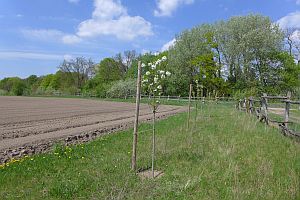
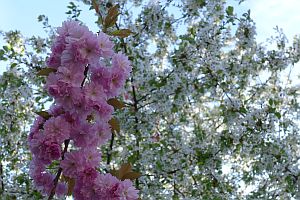

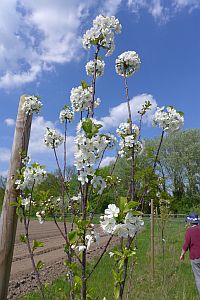

Text: Rachel. Translation: Etha. Many thanks to Sharon for correcting the English text.
April 12 -13, 2013: Shabbaton with Cantor Jalda Rebling
The Days of Counting the Omer
From Passover 
to Shavuoth 
Illustrations: Anna Adam
Cantor Jalda Rebling came up with a beautiful idea: a shabbaton during the Days of Omer counting.
Well, that was something really special: a shabbat as it should be:
Time-out from everyday life, time to let go and to refuel. Just read
the following text of her announcement and you will already get a taste
of the special world of a shabbaton:
The
new moon of the month of Iyar appears between the spring month of Nisan
and the first pilgrimage festival Passover on the one hand and the
month of Sivan with the second pilgrimage festival Shavuoth on the
other hand. Between these two festivals we are supposed to count 7x7
days. This results in seven weeks until the 50th day.
Other traditions speak of Pentacoste, in English Pentecost..
We count Omer every day. Actually Omer is a sheaf.
Which are our sheaves which we offer during the 49 days between the two festivals?
And to whom do we offer them?
Why should we offer them in a time in which most people have lost their connection to nature and often to themselves as well?
In the surroundings of the
flowering Botanicum of Gutshof Gatow we will sing T´hillim
– Psalms, tell stories, read Tora and treat ourselves to a
time-out, a real shabbat.
Jalda Rebling
We started our time-out with Kabbalat Shabbat on Friday night, - an
unhurried service with many songs and plenty of time for getting
centered and receiving Shabbat. Also Shakharit and Minkha on Saturday
we celebrated in a completely relaxed atmosphere, open for new thoughts
and time and again surprised by the beauty of the texts in our siddur
and the intensity of some of the t´hillim and prayers which are
not regularly read in traditional services.
For instance Angela drew our attention to the prayer „We are
loved by an unending love“ by Rabbi Rami Shapiro. Because of its
consoling intensity she even sometimes resorts to it in therapeutic
settings. It is found in Marcia Prager´s Siddur. We recited it
with open ears and open hearts and felt its magic.
Cantor Jalda also gave us a well-founded shiur to counting the Omer. We
had brought along several different texts ( i.e. Shifrah Tobacman, Jill
Hammer, Min Kantrowitz) and discussed their different approaches.
Singing and chanting, of course, represented an important part of this
shabbaton. Bert accompanied us with his guitar on the 23rd psalm. Some
of us were profoundly touched by texts, melodies and the rhythm of the
Hebrew language. It just got under our skin and thus created the Magic
of Shabbat.
Part of this magic was due to the time we spent with Rita in her
Botanicum. Although at first glance there was not much to see yet in
this early spring season, Rita managed to make us feel the energy of
nature surrounding us. The young plants in the green house as well as
the pumpkin and chayote which our children had planted on Tu
b´Shvat were bursting with new life. First flowers and little
green sprouts on trees were vanguards of this delayed spring. There was
growth in the air, - in nature and in us.
We received motivation and nourishment. I can´t think of a better preparation for the reception of torah.
Thank you, dear Jalda.

Botanicum of Gutshof Gatow
Many thanks to Gutshof Gatow and the Lutheran Church of Gatow who welcomed us as their guests.
Text: Etha Jimenez Illustrations and photo: Anna Adam
A special thank you to Daniel Wiesenfeld for editing the English text.
January 26, 2013: Shabbat Beshallach: Simchat Chochmah and Tu biShevat
It was a perfect match:
Rachel´s Simchat Chochmah and Tu b´Shevat.
Tu b´Shevat is the „New Year of the Trees“ when plants sense already the coming spring time and prepare for new growth. And Rachel, at the end of her professional career and with the beginning of a new chapter in her life, confirmed and reinforced her Jewish roots and prepared for new goals.
She sealed her belonging to the Jewish community and became a Bat Chochmah, a daughter of wisdom.
Dear Rachel, we are grateful that you let us participate in your joy about the wisdom of Torah and Jewish tradition. Your experience of life and positive energy will enhance (enrich) your future plans. It was a special experience for all of us when Cantor Jalda called you to read the Torah for the first time and when you engaged us in a lively discussion about your drasha on Beshallach. The Israelites crossed the Red Sea and started their puryfying journey through the desert. All of us are those Israelites, liberated from our personal mizrayim and blessed with many miracles on the road. But we can´t come to a halt here. We have to stay active and keep growing. Personal freedom and inner growth won´t be given to us as a miracle.


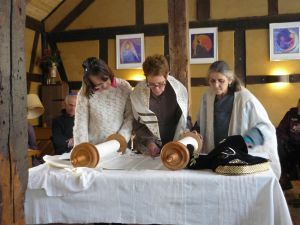

And now we were properly prepared for Tu b´Shevat. Although we could not plant trees in this winter season we planted seedlings with our children. Afterwards we went outside and tried to catch on the tune of growth of Rita´s legendary birch tree.
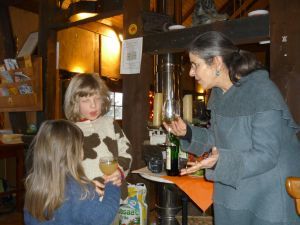

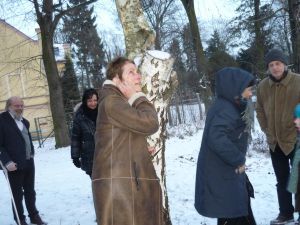

The festivity was perfected by Gaby´s delicious buffet as well as Rita´s and Ulli´s hospitality.
Many thanks and mazal tow, dear Rachel,
Text: Etha Jimenez Photos: Anna Adam
December 22, 2012: Our first Bat Mitzvah Celebration
On the 9th of Tevat 5773, Shabbat Vayigash, Sophie was called to read from the Torah for the first time. Sophie is our first bat mitzvah. As in the case of Avery our first bar mitzvah, we celebrated in the prayer hall of the former Jewish Orphanage in Berlin-Pankow. This place holds a dramatic history. In 1938, the director of the Orphanage Curt Crohn managed to save many of the children by sending them to England with the Kindertransports. The remaining ones were deported later in 1942, of which many were murdered. Presently the building is owned by the Cajewitz-Foundation and houses a private school and the Jausz-Korczak library. The room formerly used for services has only been partially renovated but still breathes its past. Ohel Hachidusch resumes the Jewish history of this room. We feel proud and honored to conduct our Bat and Bar Mitzvah services in this venerable and historical environment.


Sophie´s relatives came from all parts of the United States to share in this special day with her, neither our cold winter nor the long flight from California to Berlin, could keep her grandparents from joining her family and friends here.
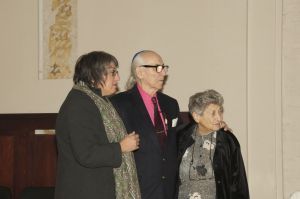
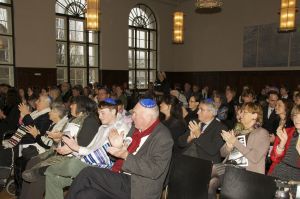
Sophie measured up to all expectations: she learned her Parsha fluently and her Dershah identified her as a self-confident member of the Jewish community, which traditionally welcomed her with a shower of candies. Cantor Jalda Rebling who had prepared her for one full year for this special day, leading her through the ceremony with empathy and humor thereby creating a familiar warm hearted atmosphere.





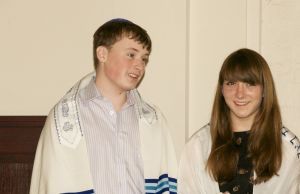
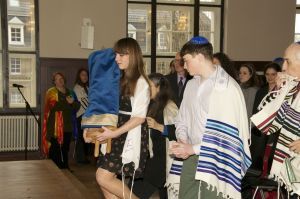
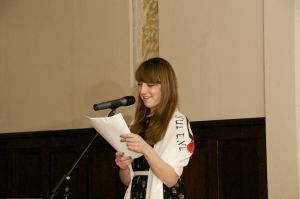
After the ceremony everybody enjoyed one of Gaby Nonhoff´s delicious buffets, and at night, of course it was party-time.
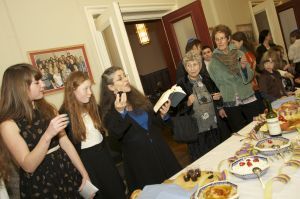
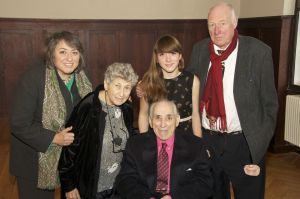
Mazal tov dear Sophie, Ohel Hachidusch hopes that in good, as well as difficult times, you will always find a place within Judaism and the Jewish community where you feel at home, no matter which part of the world you choose to live in.

Text: Etha Jimenez
Simkhat Torah 2012/5773
Ohel Hachidusch is a young chavurah but nonetheless we already enjoyed many memorable days together. Quite a few of them were special Torah celebrations:
On the 28th of November 2009 a very touching event took place in the former Jewish Orphanage in Berlin-Pankow. Together with Rabbi Arnie Sleutelberg and many members from the Shir Tikvah Congregation in Troy/Michigan, USA as well as a large number of participants and honorary guests we celebrated the donation of the Beth Jacob Torah of Shir Tikvah to Ohel Hachidusch. It was the first time since 1940 that Torah was read in the former Jewish Orphanage (read more)
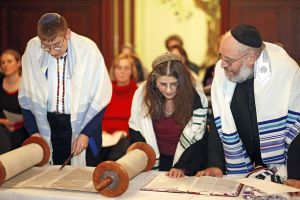
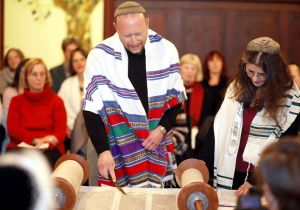
And a year ago, on October 22nd 2011, Shabbat Bereshit, we celebrated the first Bar Mizvah in the former Jewish Orphanage since 1940. We all were very moved when Avery perfectly leyned Parasha Bereshit out of our Beth Jacob Torah (read more)



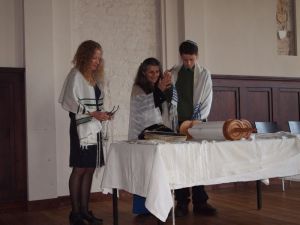
Also Simkhat Torah 2012/5773 was an extraordinary spiritual experience for all of us. Everybody was holding our Beth Jacob Torah in their arms. Some of us never got that close to a torah before.Thanks to Cantor Jalda´s highly engaged and enthusiastic torah lessons we also welcomed 3 new torah leyners . After the Torah reading Cantor Jalda drew our attention to some of the delicate adornments with which the sofer of the Beth Jacob Torah had decorated the letters of parasha Bereshit more than 200 years ago .

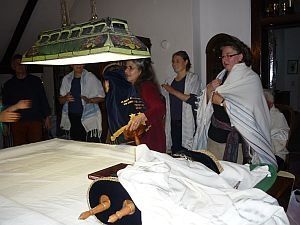

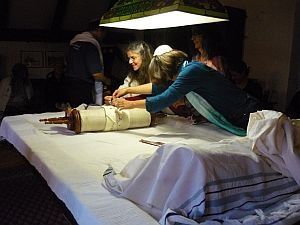
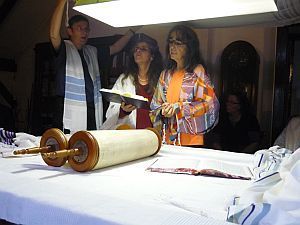
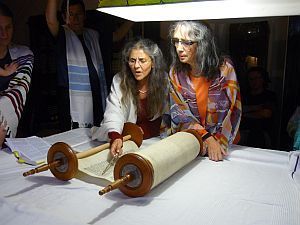


December 22nd we will celebrate our first Bat Mizva in the same special place. Sophie will be called to the Tora for the first time. Mazal tov, dear Sophie.
And already next year we´ll have another very special Torah celebration: 5 years Beth Jacob Torah in Berlin. Ohel´s creative members are already starting to plan this event.
Text: Etha Jimenez Photos: Marco Limberg, Anna Adam
Many thanks to Daniel Wiesenfeld for overlooking the English text.
Erev Sukkot 2012 - 5773
From year to year our sukkah is getting bigger, more beautiful, greener and more colorful. And thanks to Anna´s instructions our children are experienced sukkah-craftsmen. The big lawn next to the Gutshof was an ideal location for our sukkah, the weather cooperated with pure autumn sunshine and we were happy to welcome quite a few new guests. At night a big full moon was shining into our sukkah, exactly the way it was meant to be.
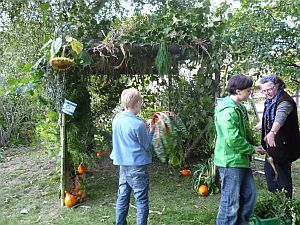
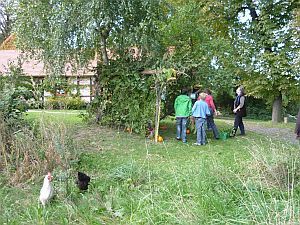
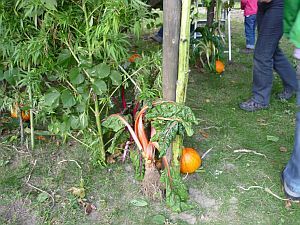
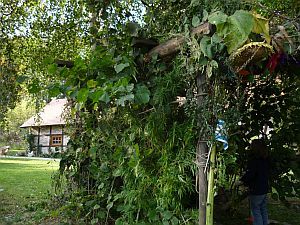
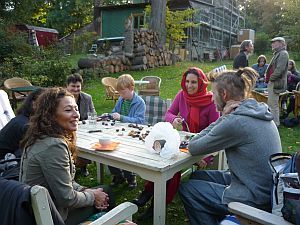



A special highlight of erev sukkot was a concert given by Cantor Jalda and Franka Lampe (accordion). They sang and played Yiddish songs of the archive of Lin Jaldati z´´l, Cantor Jalda´s mother, and arranged by Franka with so much heart, spirit and empathy. It was a very moving experience.
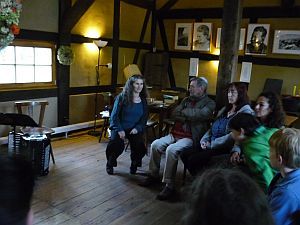
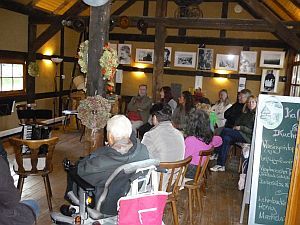
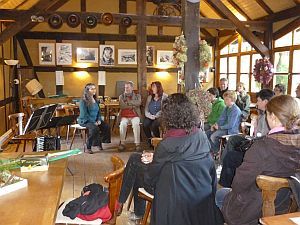

In bright star- and candlelight we completed an exceptional holiday with a delicious kiddush
to which everybody had contributed.

Photos: Anna Adam
Text: Etha Jimenez
Special thanks to Donna for looking over the translation.
Rosh Hashanah 2012 - 5773
During the afternoon of the first day of Rosh Hashanah we met at a hidden but easily accessible place at the shore of Berlin´s Havel. We celebrated a modern variant of tashlikh, a rather moving ritual dating back to the 13th century. Anja had organized water-soluble paper and we wrote down which aspects in our behavior towards fellow men we would like to change in the year to come. It was a special moment when the little pieces of paper were carried away by the flowing water. When they were out of sight the deep, archaic tekiah, shevarim and teruah of the shofarot of Susanne and Anna carried our thoughts to previous years. We felt united with all Jews all over the world who start the year 5773 with new hopes.
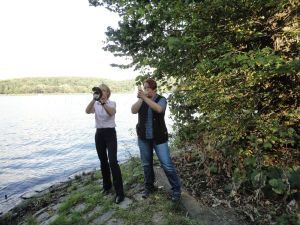

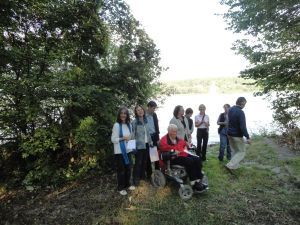

We conducted Maariv prayers under the guidance of Anja in Rita´s Garden of World Religions and as many times before we were moved by the garden´s special spiritual atmosphere. A rich kiddush prepared with the healthy vegetables from our eco-field on Rita´s beautifully decorated table completed this special holiday.


Many thanks to Anja who guided us through the liturgy with competence, to our adept shofar players Susanne and Anna and to Ulli and Rita from Gutshof Gatow for their warmhearted hospitality. And special thanks to Donna who looked over the English text.
Photos: Gaby Nonhoff Text: Etha Jimenez
Tu b´Av 5772/ August 3, 2012:
Gaby is sharing her beautiful pictures with us and is inviting us to a virtual walk through the Garden of World Religions and our ecokashrut-field in Gatow, just perfect for Tu b´Av. Thanks to Rita´s gardening talent and empathy for all plants as well as the help of some equally enthused ohelistas their abundant growth and special atmosphere are eye catchers and soul soothers:

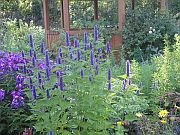

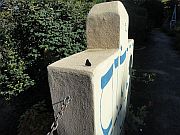

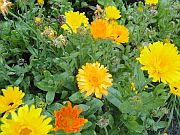

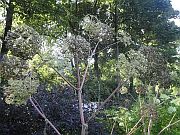

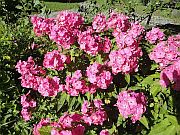
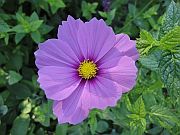
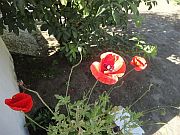




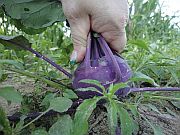



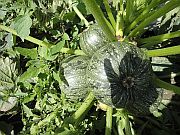

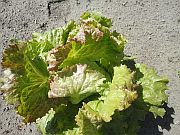
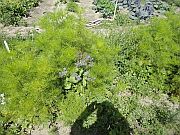
Photos: Gaby Nonhoff
Donna is our "Writing Girl"
We are proud that our member Donna Swarthout participates in the Berlin Writing Project "Writing Girl" sponsored by Aviva Online Magazine for Women (http://www.aviva-berlin.de) and Stiftung Zurückgeben.
Just click the link below and read the touching story which Donna wrote in honor of her great-aunt Meta Adler who was murderd in the Shoah. With this article and a Stolperstein (Bar Mitzvah Project of Donna´s son Avery) Donna is keeping the memory of her great-aunt alive.
http://www.aviva-berlin.de/aviva/content_Juedisches%20Leben_Writing%20Girls.php?id=141266
July 1, 2012: Rabbi Tsvi Blanchard visits Ohel Hachidusch
We were fortunate again that on Sunday, 1st of July 2012 Rabbi Blanchard gave us a shiur and visited our eco-kashrut project in Gatow. He is an orthodox Rabbi , Director of Organizational Development at CLAL - The National Jewish Center for Learning and Leadership and holds PhDs in Psychology and Philosophy. He also holds the chair of the Meyer Struckman professorship of Jewish Law at the Humboldt Law Faculty. And much more. Just have a look on his biography at
http://torahinmotion.org.c1.previewmysite.com/spkrs_crnr/faculty/bioTsviBlanchard.htm
His shiur was on Gen 11, 1 - 8 (the Tower of Babel), parasha Noach). In contrast to the usual interpretation that God punished mankind´s defiance and rebellion, Rabbi Blanchard offered his view for discussion stating that the multiple language is a chance for cultural varieties, new ideas, vision and overall growth in life and enables mankind to avoid stagnation. All of these are basics for communities to avoid fatal stagnation. We were fascinated by this suggestion reminding us to keep striving for diversity at Ohel Hachidusch.




After the shiur Rabbi Blanchard gave us the opportunity for further questions. Since the ruling of a district court in Cologne which banned religious circumcision of minors as criminal offense just happened a few days earlier there was plenty of need for discussion on this topic. I personally was struck by Rabbi Blanchard`s remark that he expected something like this judgment to happen in Germany. Some of the questions of his law students at Humboldt-University had alerted him to the problem. Could it be that the proverbial German angst condemns ritual circumcision but really means the different cultural and religious Jewish background?
I was very impressed by Rabbi Blanchard´s gift to give down to earth advice and food for thought. Above all his academic achievements he is a mentsh. Dear Rabbi Blanchard, thank you very much for not only giving us this shiur on diversity but also demonstrating it.




Text: Etha Jimenez Photos: Anna Adam
Many thanks to Blanca Rudhart for her corrections of the English text.
Erev Purim 2012
Ohel Hachidusch was really lucky: Carolyn Landry surprised us with her charming Purim Puppet Show. All puppets and the stage setting ( (Ishtar Gate) were designed and lovingly handcrafted by herself. Just look at all these meaningful details:
Claudia and Daniel turned out to be talented puppeteer apprentices and Cantor Jalda enlivened this version of the Scroll of Esther professionally. Naturally there was also plenty of room for spontaneous ideas and suggestions.
The audience was very impressed, especially our children. Ben never failed to recognize Cantor Jalda´s ominous change of voice whenever the name of Haman (Cursed be Haman) was coming up and answered with the full array of noisemakers arranged around him.
Naturally most of us came in costumes. Between punk and roboter there was an impressive scale of fanciful disguises.
All puppet players and noise makers enjoyed our kiddush with abundant and delicious home-made food. Naturally all sorts of hamantaschen dominated the beautifully decorated table to symbolically outsmart all Hamans of this world.
We thank everybody who joined hands to celebrate a joyous and meaningful erev Purim. Of course, special thanks go to Carolyn . Dear Carolyn, please return soon with your gorgeous puppet ensemble.
Text: Etha Jimenez
Photos: Anna Adam, Gaby Nonhoff
Pesakh 5772 - 2nd Seder in the tent of Ohel Hachidusch
Many had been helping to prepare this special evening: under the guidance of Marlis we boiled all kitchen utensils and cleaned the kitchen and our festival room of all khametz, moved chairs and tables around, went shopping, carried beverage bottles, snipped vegetables, cooked and decorated. In the end our seder table was very festive and just beautiful. Everything was affectionately prepared for our guests. "Even more beautiful than last year", said Anna after looking around with the expert glance of an artist. Well, our nicely adorned tent really looked more gorgeous than last year thereby holding the promise for further pleasant surprises. All in all we were 50 seder guests, the perfect size for our huge tent. Some of our guests had come from far away and one participant had never before attended a seder. Our children were bustling around in our playground area in the center of the room and were surrounded by our u-shaped dinner table which was adorned with colored spring flowers and promising delicacies.

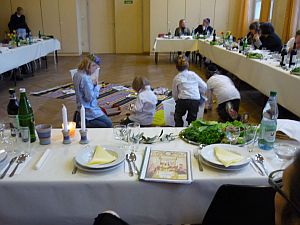
Naturally it was also well endowed with all ritual objects, including an orange. Before starting the meal it was explained to us that years ago Susannah Heschel gave the impetus for their appearance on the seder table.

Our guest of honor was Rabbi Levinson with Annemarie Werner as his thoughtful helper on his side. In his advanced age he stayed in his own presence most of the time. But later on when we ate the ritual foods and sang the traditional songs I was sure that he had joined us in our spiritual exodus from mizrayim.
The attention of our festively dressed group concentrated on our Cantor Jalda Rebling. She would lead us safely through the Haggadah.
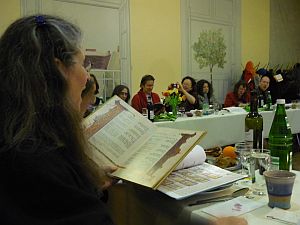

At the beginning of our seder she mentioned the tradition of the Jews of Trontheim (Norway) who - to be on the safe side in the dark season- adjusted the beginning of their shabbat to Jerusalem time. She also explained that it is customary to extend the duration of a Yom Tov. Then she lit the menorah with a lighted candle. Kadesh - the first step. And then we moved on, step by step, out of mizrayim and toward liberation. Jalda commented that only after the exodus the Israelites were able to recognize their previous bondage. The choice of freedom implied to leave the security of mizrayim behind and dare the insecurities of exodus. Cantor Jalda demonstrated the political up-to-dateness of the Haggadah with an example: the Torah says that Pharaoh started to fear the Israelites when they had grown into a big people. He insinuated that they would start war with other nations. How old and yet completely up-to-date is this allegation! I think there always will be camels around modern pharaos ruminating this grass... in the belief that time would have cleared it from all noxious substances. (The pun refers to the scandalous "poem" of Günter Grass and his criticism on Israel). We will not forget and remember well.
Finally we started our delicious eco-kosher meal! Prepared with love and experience by our chefs Anna and Gaby and their talented helpers. This joint venture mocked all vernal diets. The lamb was pure British fine taste, the side dishes outplayed each other in their race for remaining spaces in our stomachs. But ultimately there still was some room left for the munchy-crunchy matze-cake. This lead us to the search of the afikoman. Ben found it with the intuition and sure instinct but naturally there was a gift for every child. Elia ,of course, got his cup of wine and Miriam her glass of water.
Our Ohel seder came to an end with the familiar songs and counting of the 1st Omer. Next year in Jerusalem! Or in Berlin? My father, z´´ l´´ used to say: now we are remembering our distant dear ones! I think during seder we are sharing a feeling of solidarity with many of us because the awareness that all over the world, all around the clock, for many generations before us, Jews are celebrating with us, strengthens and encourages us.
Text: Deborah Williger Translation: Etha Jimenez Photos: Anna Adam, Gaby Nonhoff
Tu Bishvat 2012
When opening the door to Rita's and Uli's "Remise" (the former carriage depot, now cafe in Gatow), it feels like walking right into a beautiful picture book for the senses. The soft light, the aromatic smell of herbs and wood on the old stove, the warmth and the kindness that embrace the visitor bring a smile to everyone's face and make you feel truly sheltered. It's hard to imagine a better place to remember the good that's flowing towards us at any given moment, sustaining us just like this, as a present.
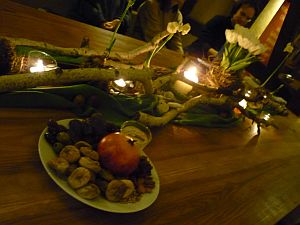
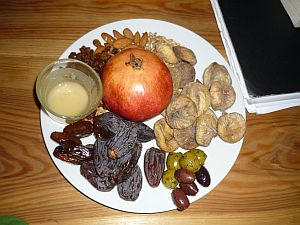
Sitting around the table that has been beautifully decorated for the occasion by Rita, we listen to Franka playing the accordion and Jalda singing a rediscovered niggun from her mother's repertoire.
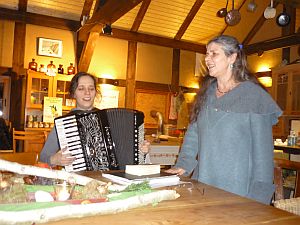

Jalda, Dvora, Anja and Marlis have prepared texts for us to explore different aspects of Tu BiShvat. We learn about the idea in the Kabbalah that every pleasure in this world has its correspondence in the hidden world. Dvora explains how eating a fig can be compared to studying Torah: just as all the parts of the fig are edible, all parts of the Torah can be savoured spiritually, even those that appear difficult at first glance. A few words from the P'ri Eitz Hadar, a haggadah for Tu Bishvat from the 18th century, I find especially touching:
"May all Creation return to its original strength... And may all the sparks of divine energy, whether scattered by our hands or by the hands of our ancestors, be returned and included in the majestic might of the Tree of Life."
Together, we say the blessing over the crops of Israel that have been arranged on a plate: wheat and barley, grapes (due to the season in the shape of raisins), figs, olives, dates and honey, a pomegranate - and even almonds have been included.
After having enjoyed the delicious food that people have brought along - the icing on the cake being a fantastic fruit salad - we step out into the cold with candles to visit the birch tree. What a wonderful opportunity to marvel at the full moon and the clear, starry sky! Given the minus degrees, however, the birch tree wants to go on sleeping for a while; we cannot hear the sap rising just yet.

Back in the "Remise", Lilly who is the youngest among us today, plants pumpkin seeds for future Kiddush soups.

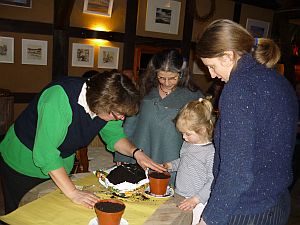
We conclude the evening by listening to Rita's fairy tale about the shepherd without sheep who saves an elderberry tree and is rewarded with a very good job opportunity and a very handsome bride.
Text: Isabelle Wagner Photos: Anna Adam
Sukkot 2011/5772
It is already one of Ohel Hachidusch´s beloved customs to celebrate Sukkot in different sukkahs.
October 12 and 14, erev sukkot and erev Shabbat Chol haMoed Sukkot we were guests of Chajim and the Kulturverein Prenzlauer Berg (www.kvpb.de). Just a few hours before the beginning of sukkot Jalda and Anna returned from Detroit/ Michigan. As in previous years Cantor Jalda officiated at Shir Tikvah Congregation during the High Holy Days. Both Jalda and Anna were anxious to share their new ideas and exciting experiences with us and tell us about Shir Tikvah´s hospitality. Therefore. jet lag and lack of sleep were without chance. Jalda lead us through the service and we were happy to have both of them home again.

Erev Shabbat Chol haMoed Iris Weiss provided us an insight into bibliolog (www.berlin-juedisch.de/ bibliolog). With this method biblical stories are retold or continued out of the perspective of other " eye witnesses" thereby transcending or actualizing the events wherever intuition or subconscious come to a stop. This evening we centered on Rachel and Jacob´s love on first glance. It was fascinating to look at one of the most beautiful and multifaceted love stories of the bible from different points of view.
Subsequently Olaf Ruhl sang and played yiddish songs and we hummed along. The evening was perfectly rounded by a delicious homemade meal of Channah and other equally creative hobby cooks. Many thanks to all contributors to this inspiring festival.
Sunday, October 16, 4th day of sukkot we spent in our own sukkah in the garden of landhouse Gatow in the outskirts of Berlin. This day we centered on the agricultural aspects of sukkot. We were proud to visit our ecokashrut field with our guests and say some prayers of thanks for our first year´s harvest which surpassed all expectations.
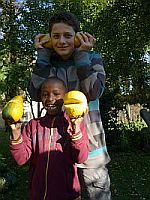

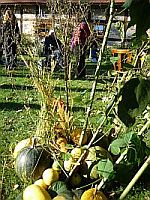


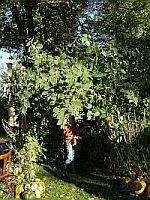
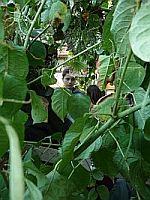

Thereafter our children enthusiastically decorated the sukkah with some more flowers and fruits from our field. We said the blessings under the guidance of Anja and bentshed the lulav. Later on we enjoyed some of the first honey of the bees whose hive is located in the garden of world religions just a couple of yards away. The honey was very tasteful and aromatic which was no surprise since the bees are feeding on Rita´s organically grown flowers.
After this outdoor day all of us were very hungry. Thanks to the generosity of Rita and the expert help of Marlis and Jona a beautifully decorated table with homemade delicacies of the landhouse was waiting for us. Many thanks to everybody who contributed to this special sukkot experience.


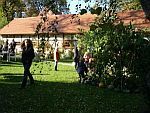
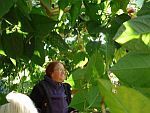
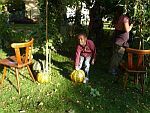
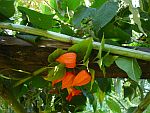
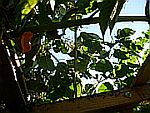

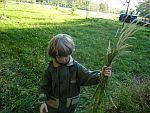
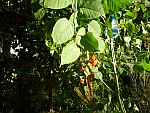
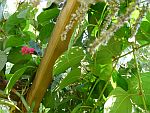

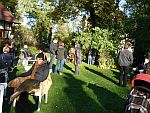
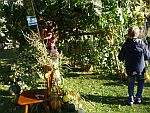
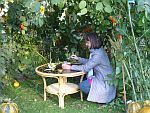
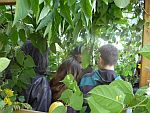

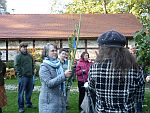


Photos: Anna Adam, Ruth Wiesenthal
Global day of
Jewish Learning: November 13, 2011/
Kheshvan 16, 5772
Planting 18 trees
(chaj) at the Ohel Hachidusch Eco-Kashrut garden in
Berlin – Gatow
It was a gorgeous day: sunny and clear,
just beautiful.
We met in the early afternoon in our garden to welcome the new fruit-trees of old sorts coming from an ecological tree-school. As we prepared this event everybody chose his own personal tree. Some of us wanted to plant the tree for his or her ancestors others just loved the fruit which one day, b´estrat HaShem will grow on this tree and enjoy life.
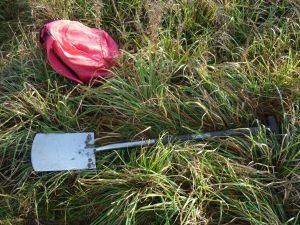
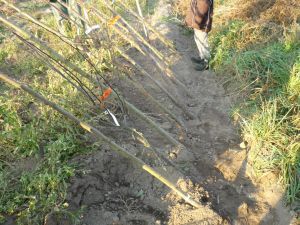
For us people mostly living in an urban environment
it was miraculous. A
huge learning lesson about the second paragraph of the Schma. If we
treat our
world as she needs it, we will get so much.
We human beings as partners of nature, not as
„rulers“ over nature.
As we started to dig, helping each other, we learned that the first dig is the hardest one: you have to get through the grass-cover. When you understand what you are doing/learning, then you can dig deeper and will not only learn the Pshat but also the deeper levels.
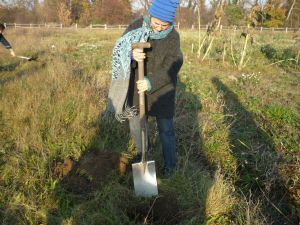
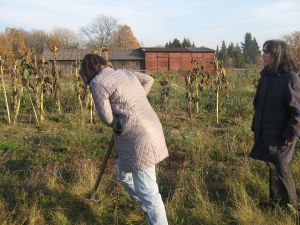


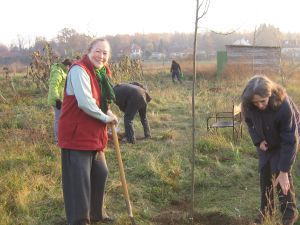
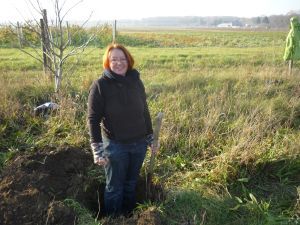
When the wholes were deep and big enough for the roots of the little trees, then water – mayim hayyim - was needed, a lot of water. After we closed the earth everybody gave his or her little tree a blessing, a personal blessing, thankful for reaching this moment in our lifes.
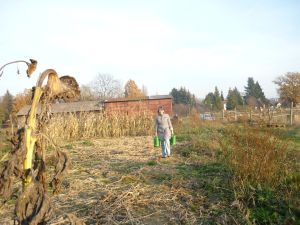


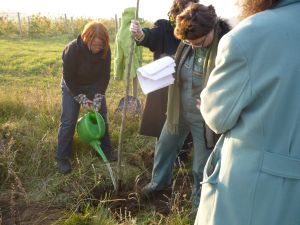
We blessed this moment with a shehechejanu.
After about two hours work we looked at our new orchard-alley. May it grow and make our lifes and the lifes of those who will harvest the fruits richer.
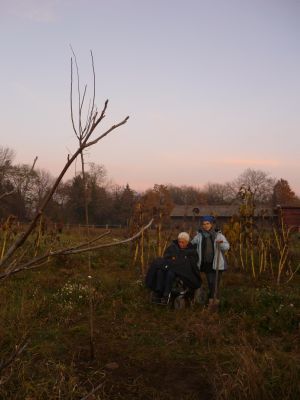
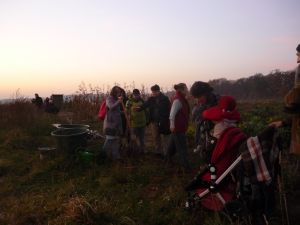
Some of us immediately planned to plant more next
year.
Ol malkhut shamajim means the connection between heaven and earth,
like a
tree. When the roots are strong the tree can blossom and withstand the
wind,
the frost and all difficulties in his life.
We will harvest our first fruits after five years,
because Tora teaches
us not to take the fruit of the first four years and to bring the
harvest of
the fifth year as a korban.
The trees giving us the connection to the
generations before us and
those who are coming behind us.
They are a part of the golden chain of our
tradition. They are
representing the tree of life.
And we all learned, that the study of Tora gets a
deeper meaning when
you go cultivate the earth and dig through the first grass-cover into the depth of life.
With a delicious pumpkinsoup made of the pumpkins growing in our garden, joyous singing and storytelling, we celebrated the day. A beautiful moon at erew Kheshvan 17th guided us on our way home.

Text: Cantor
Jalda Rebling
Photos : Anna Adam
Tishri 24, 5772 -Shabbat Bereishit -: Our first Bar Mitzvah



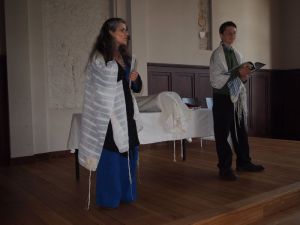
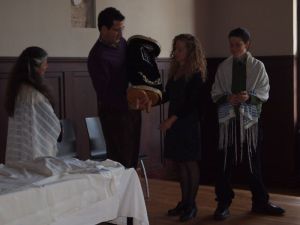


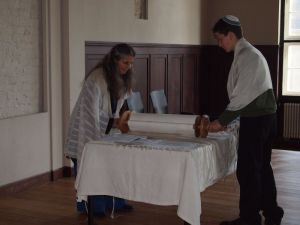

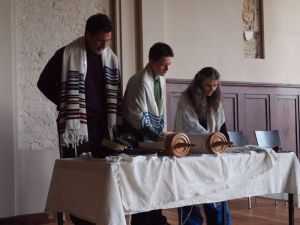
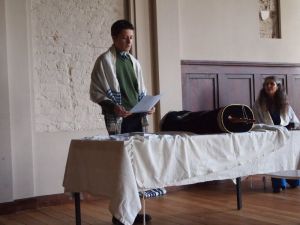
A German American Jewish Celebration
Posted on October 28, 2011 on Donnas blog Full Circle
 A boy becomes an adult and
reclaims his family’s place on the soil from which his
ancestors fled two generations ago. Berlin’s
former Jewish orphanage, with its historic prayer hall, marks the first
bar mitzvah since the Shoah. Ohel
Hachidusch, a congregation outside Berlin’s mainstream Jewish
community, embraces its first son of the commandments.
A father weeps to see his first-born step with
confidence into adulthood. A mother
aches with joy as she stands on the bima, the living link between the
father she’s lost and her son who is his namesake.
A boy becomes an adult and
reclaims his family’s place on the soil from which his
ancestors fled two generations ago. Berlin’s
former Jewish orphanage, with its historic prayer hall, marks the first
bar mitzvah since the Shoah. Ohel
Hachidusch, a congregation outside Berlin’s mainstream Jewish
community, embraces its first son of the commandments.
A father weeps to see his first-born step with
confidence into adulthood. A mother
aches with joy as she stands on the bima, the living link between the
father she’s lost and her son who is his namesake.
 These were the heavy layers of
symbolic meaning that enveloped Avery’s bar mitzvah last
weekend. But the deep significance
of the occasion didn’t keep us from having a fun and rowdy
celebration. Avery got hammered
with German and American candy at the end, and sustained a pretty
strong hit on the forehead from a rock hard treat thrown by his little
brother. I think Avery and one of
his buddies also got hammered with a secretly made potion of wine and
iced tea!
These were the heavy layers of
symbolic meaning that enveloped Avery’s bar mitzvah last
weekend. But the deep significance
of the occasion didn’t keep us from having a fun and rowdy
celebration. Avery got hammered
with German and American candy at the end, and sustained a pretty
strong hit on the forehead from a rock hard treat thrown by his little
brother. I think Avery and one of
his buddies also got hammered with a secretly made potion of wine and
iced tea! 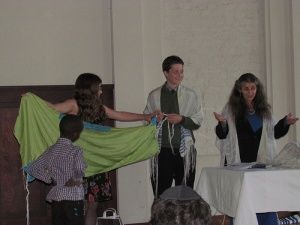 Avery chose to have his coming
of age on the anniversary of my father’s bar mitzvah.
He wore the tallit (prayer shawl) my father wore 69
years ago when he was first called to the Torah. But
as the service drew to a close Olivia dazzled us all by presenting her
brother with a beautiful silk tallit she made by hand for him.
As Cantor Jalda said, “Avery should step
into the future wearing his own tallit, not schlepping the burden of
his grandfather on his shoulders!”
Avery chose to have his coming
of age on the anniversary of my father’s bar mitzvah.
He wore the tallit (prayer shawl) my father wore 69
years ago when he was first called to the Torah. But
as the service drew to a close Olivia dazzled us all by presenting her
brother with a beautiful silk tallit she made by hand for him.
As Cantor Jalda said, “Avery should step
into the future wearing his own tallit, not schlepping the burden of
his grandfather on his shoulders!”It
was a day of profound peace and joy for me. As
my son chanted his Torah portion in a clear and resonant Hebrew that
apparently carried no trace of an American accent, I saw the beauty of
a ritual that ties all Jews together. Sharing
that ritual with our mostly non-Jewish friends from Berlin (as well as
our family from Amsterdam and two dear friends from the U.S.) gave us a
sense of belonging in our new community so far away from Montana.
We are indeed a “German American Jewish
family” that is comfortable following our beliefs in both
countries that we call home.
Text by Donna Swarthout in her blog Full
Circle
Photos courtesy of Bill Slaton.
Avery´s Bar Mizwa Projekt:
Stolperstein for Meta
For my bar mitzvah, I chose a project to make the world a little better place. After a trip to Southern Germany where I learned a lot about my family history, I decided to help my family create a memorial for one of our relatives who was killed in the Holocaust. We chose to have a Stolperstein made for my great great aunt Meta Adler. Stolpersteins are brass stones set in the ground to remember individual Holocaust victims.
I´d like to tell you a little bit about Meta. She was born in the small village of Altwiedermus in 1894. She was neither pretty nor very smart, she never married, and she worked as a maid. Because she could not successfully answer questions during her immigration examination, she was denied permission to immigrate to America with the rest of her family. So, in 1938-1939 the Adlers immigrated to America, leaving Meta behind. She then lived in Frankfurt until she was deported in 1942. In her memory, the stone will be laid in her birthplace of Altwiedermus this summer.
Text: Avery Swarthout

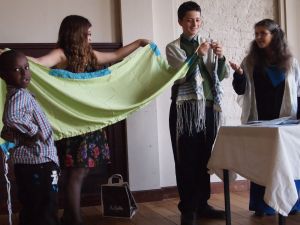


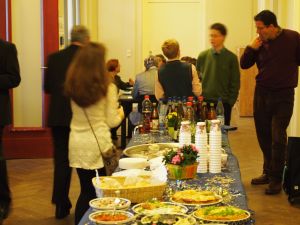
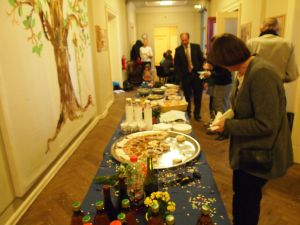
Many thanks to Donna for her translation and to Barbara Swarthout for all pictures except the ones in Donna´s blog . If you want to learn more about the life of our American - Jewish - German family in Berlin please check Donna´s blog Full Circle .
Minkha Learning Session with Reb Dr. Goldie Milgram from USA
Saturday, August 27, 2011/ 27th of Av 5771 (Shabbat Re´eh) was a special day for us:
We were happy to welcome Rabbi Dr. Goldie Milgram from the USA and her husband Dr. Barry Bub as special guests to our Minkha Learning Session at Gutshof Gatow.
Rabbi Milgram was ordained at Reconstructionist Rabbinical College, received a smicha from Rabbi Zalman Schachter-Shalomi and a doctorate from New York Theological Seminary. She founded Reclaiming Judaism Press and www.ReclaimingJudaism.org. This organization is developing new strategies to keep Jewish rituals and mitzvot alive. She also wrote several books on these topiics.
Jona wrote down the way she experienced this fascinating learning event:
Spiritual and Bodily Nutrition at the Farm: Rav Goldie Milgram learning with Ohel ha-Chiddusch:
Gatow, nearby Berlin in Elul 5771 (2011). A metallic grey sky weighs heavily on the village, on the fields and on the farm. The wind blows thick rain drops onto the little windows of the farm house. Given such a weather everybody wants to stay in the house – a good time for retreat and to concentrate on what is inside. Gladly we did so thanks to the hospitality of Rita and Ulrich Reinicke, who take care of the farm and mill in Gatow; and thanks to Rav Goldie Milgram, who followed the invitation of Ohel ha-Chiddusch and came to Berlin together with her husband, Dr. Barry Bub.
R. Goldie Milgram is known for traveling through the world with the message in her luggage, that Jewish tradition is not just a huge library, which invites for extended intellectual examination. First of all it provides a deliberate set of exercise and guidance for a practical spirituality and a life well balanced between body, soul and spirit. Dr. Barry Bub is a physician and a Gestalt psychotherapist. He leads a lot of workshops and seminars on how traumatized people could be helped with integrated healing. Integrated healing means, a sincere therapeutic work has to be complemented by a vivid spirituality founded in tradition. And the other way round also spiritual exercise would not do enough, but has to be accompanied by professional therapy. Both must come together in order to gain sustainable healing.
Healing is also a leading theme in the time of repentance between Rosh ha-Shanah and Yom Kippur, and also in the preceding month of Elul, where we usually prepare ourselves for this exceptional time. Tradition helps us to fathom at first, where we were hurt, and when we ourselves caused unpleasant experiences for others. In the stress field between forgiving and allowing forgiveness the realm of a new beginning is opened. On one hand this costs us quite an effort to approach somebody else, when we became ourselves a source of hurt for others; on the other hand it demands of us to be open for the offer of someone else to settle a dispute and to leave our anger behind.
Like in other situations we can take God as a role model: it is written in the Bible. One impressive example of changing his mind is presented in the story of the Deluge. God himself does Teshuwah, and turns around in order to take a new perspective and to change his attitude. In this case he decides that he would never ever allow again such a destructive power to dash over the surface of the earth (Genesis 8:21.22; 9:12-16). And later, after the blooper with the Golden Calf, he gives Moses the chance to convince him not to abandon his people and to create a new one out of Moses. God agrees to try it again with the same Israel (Exodus 32:7-14). Therefore also in case of forgiveness preceded by repentance we can make use of the theological concept of imitatio dei, of imitating God. Differently from the other two monotheistic sister religions Jewish tradition gives us more freedom to think of God also as a being who is not perfect, but who himself is developing over time.
But the teachers of Jewish tradition were also profound psychologists, and were aware of the limits to be open and willing to forgive. A limit is set by the health of a person. It is allowed, and even commanded to protect oneself from notorious, continuous injury by others. Here Jewish tradition and spirituality is very realistic and even provides guidance to put necessary distance into a conciliatory a form. Only one thing is very important for the sake of one´s own integrity: the aggrieved party should not fall into feelings of dislike or even hatred; she or he can avoid this by consciously submitting the situation into the hands of God, the very principle of encounter and attention.
This is the palette of topics R. Goldie Milgram opened up for us in the rustic and homely room of the farm house. In a lecture she led us at first into a vivid discussion with prominent voices of tradition – from the Talmud to the great Rav Moses ben Maimon and contemporary representatives. But she also encouraged us in exercises to go into contact with a situation of how it would be to approach somebody and to practice Teshuvah, and to allow a change of perspective. So, she opened up for us the days of Teshuvah as a great source of healing from pain – exactly as it is intended by Jewish Renewal. Most of our pain is caused by interpersonal relations; therefore these relations are also the realm, where dissonance and conflict have to be overcome. A devout ejaculation to God in the synagogue is not sufficient. A request for pardon in front of God unfolds its effect at best by directly approaching the human counterpart.
„Man does not live of bread only“ (Deuteron. 8:3), but he also does. Therefore we sat together afterwards in the warmly illuminated room, and enjoyed bread, wine, and all the tasty food . We continued our exchange of ideas sitting around the richly set table, until it was time to no longer shy away from the rain and to return into the daily routine with all its challenges.
Text and translation Jona Kirchner


Photos courtesy of Dr. Barry Bub
Eco-Kashrut II: Our field in summer 2011

It is hard to believe how our little grains and seeds from spring developed, just have a look:


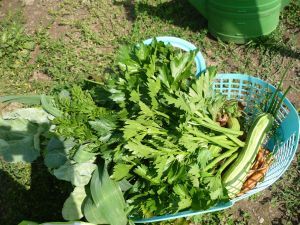
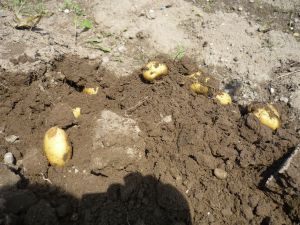


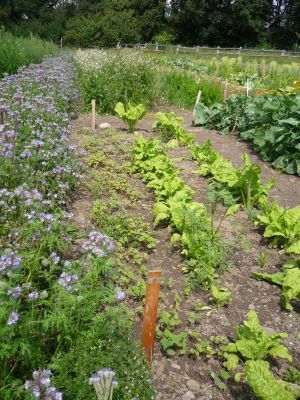

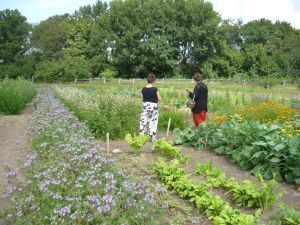
 Thanks to Rita´s "green thumb", our own enthusiasm and -last
not
least- help from above, our harvest surpassed all expectations. Big
enough for our kiddushim, our private needs and to share with
others.
Thanks to Rita´s "green thumb", our own enthusiasm and -last
not
least- help from above, our harvest surpassed all expectations. Big
enough for our kiddushim, our private needs and to share with
others.
Our bio-vegetables for whose care and growth we were responsible belong
into a special energetic spiritual sphere. Just like hagafen and
challah.
At a sunny summer weekend we celebrated another premiere in the Gatow estate: we baked "Flammkuchen", a special flat cake originating from Alsace in the traditional adobe oven. With sour cream and our fresh vegetables from the field it was a special delicacy.


Lag b´Omer and Eco-Kashrut
May 22nd 2011, on Lag b´Omer, Ohel Hachidusch enjoyed the hospitality of Rita and Ulli Reinicke, the founders of Gatow Botanical Garden with its Garden of World Religions. We are spending almost all of our outdoor festivals in this serene country atmosphere. On this sunny spring day we enjoyed the splendor of the biblical plants which grow in these Gardens. Later on we lit a bonfire in honor of Rabbi Shimon bar Yochai. Our children were fascinated, especially when we baked our whole grain bread in it. Of course, it tasted delicious.And in the evening we counted the Omer and were very aware of the diversity of nature (Hod she b`Hod, Splendor within Splendor).
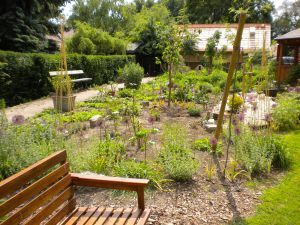
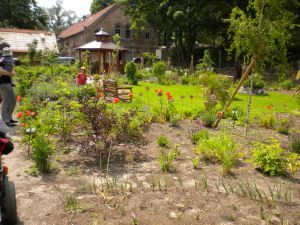
But there was even more to this day. Ohel Hachidusch could fulfill one of its dreams. Under the guidance of Rita we may farm a piece of land according to eco-kashrut rules. This day we planted potatoes, zucchini and Swiss chard. Our children have their own bed for seeding and making their first experiences in planting, caring and harvesting.

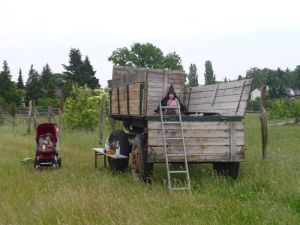



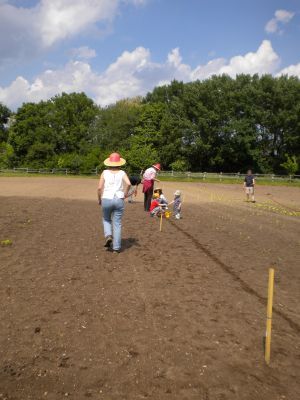
We have always been very anxious to serve organic whole vegetarian dishes for kiddush. But now we even care for our food from planting to eating. No chemicals, no pesticides, no genetically modified plants. Rita told us, it was extremely difficult to secure some grains of a species of corn which had not been genetically engineered yet. Hopefully we will produce enough vegetables and potatoes for our kiddush dishes, soups and probably also some for private use of our members.Thus we are not only cultivating plants but spiritual appreciation and respect for nature as well. It is one possibility to contribute to Tikkun Olam in our immediate environment and probably is part of this kind of spiritual ecology which Rabbi Zalman Schachter-Schalomi had in mind when he coined the term "eco-kosher".
Pictures: Anna Adam and Rita Reinicke
Pesakh 2011: 2nd Seder / Erev 16th of Nissan 5771
Besides all joyful anticipation our seder presented a logistic challenge: Our original limit was 40 participants. But due to short notice of guests from abroad we were almost 70 persons, including 20 children. Therefore first of all we owe a big thank-you to all members of our well-proven "organization-shopping-cooking-decoration-team" under the experienced guidance of Anna Adam and Gaby Nonhoff. They managed to create a touching festivity without hectic rush.






Our Cantor Jalda Rebling officiated and lead us skilfully and empathetically through the Haggadah; it was a spirited gathering of song, learning and good food.

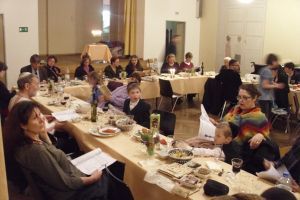
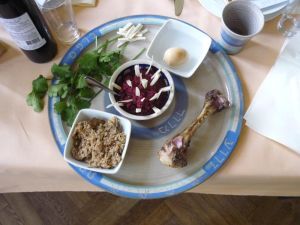


And everybody had sufficient leisure to reflect his personal constrictions and possibilities to overcome individual limits. At the end of the meal our clever children found the afikomen rapidly and we concluded our seder.
The pictures mirror the relaxed but festive atmosphere and the positive energy around. Whoever wanted to engage into the meaning of pesakh was able to feel and "taste" the beauty of this festival at this seder.


We thank all guests who opened their hearts and everybody who participated in the organization of this evening and -last but not least- helped cleaning up.
Photos by Anna Adam and Brian Swarthout
Lernfest for Lilith and a very special menorah:
On February 5, 2011/ Rosh Chodesh Adar 5771 we arranged a "lernfest" for Lilith. We will always miss her. Since Lilith profoundly disliked solemn speeches we kept her memory alive with stories, sang her favorite chants and exchanged photos. Everything was rounded off perfectly by a kiddush with Viennese specialties. Lilith´s cousin Gaby contributed delicious Viennese patisserie and typical Viennese lore.

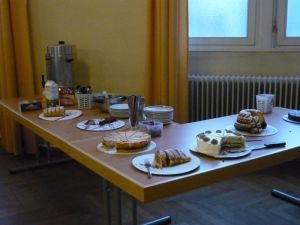
Lilith had strong emotional ties to liturgical music which transcended her awareness of life and vitality but also her profound grief. She was very open-minded about other world-views and their values. Therefore we are very grateful that close friends of Lilith from her mantra-choir shared their sacred songs, photos and experiences with us. All memories stressed Lilith´s open-heartedness, zest for life, tolerance, humor, strength, charisma, charming toughness and -above all- her big heart. Well, all this is Lilith as we will always remember her at Ohel Hachidusch.


The evening closed in a manner which Lilith would have enjoyed: a beautiful ancient menorah from Austro-Hungary was passed on to Ohel Hachidusch. It was handed to us by Monika Wissel who was also acquainted with Lilith.
Here Monika Wissel is telling the story of the menorah:
"The menorah belonged to Ingrid Ehlert née Fenichel (born 1926), her father brought it from Hungary to Berlin. The parents of Ingrid Ehlert owned a store for theater costumes and accessories in Berlin-Neukölln. During the Nazi regime her mother had to continue the business by herself since Ingrid´s father was Jewish. Although Ingrid was raised Christian she had to leave secondary school and shovel coals instead. Part of her family was deported. But little is known about Ingrid´s life since 1933 because she hardly talked about these years. Her 4 years younger sister married a Jew, emigrated 1954 to the US and lives in a Jewish environment in San Francisco. Ingrid and Günter Ehlert had a civil marriage in 1949. Until September 2008 the couple lived in their house in Berlin-Tempelhof but then they moved to an old people´s residence. Ingrid Ehlert died there only 2 months later. Günter Ehlert is 93 years old by now. In accordance with his wife´s wishes he gave the menorah to an active Jewish community."
Thank you very much, dear Mr. Ehlert and dear Mrs. Wissel, from now on the menorah will shine on all of our festivals.
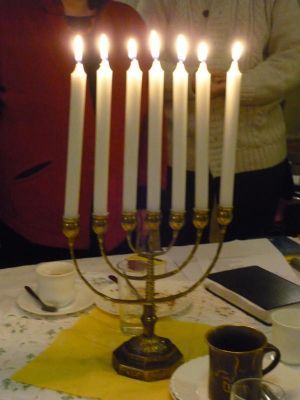
Photos: Anna Adam
Tu biShevat 2011
On January 20, the 15th of Shevat we celebrated Tu b´Shevat, the „New Year of Trees“, in the remise of the Botanicum in Berlin-Gatow. Once again we enjoyed the hospitality of Rita and Ulrich.
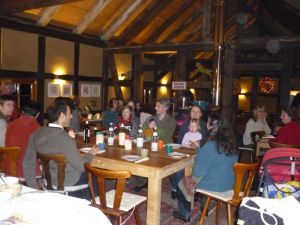

Our children seeded kernels of pumpkin, planted spring snowflakes and bentsched the plants under Cantor Jalda´s guidance.
We hope that the snowflakes will blossom soon and herald spring in Berlin while the pumpkin with its gorgeous orange color will decorate our Shavuot table.

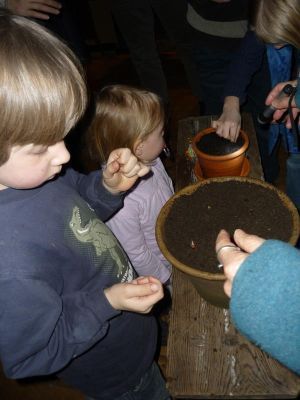
After the planting ceremony we all enjoyed our seder with various biblical fruits and a delicious eco-vegetarian dinner. We thank everybody who had a share in our festive
buffet. As always we sang a lot and told stories suitable for Tu b´Shevat. Just a few hours earlier Cantor Jalda had returned from the US and brought with her many greetings from our partner congregation Shir Tikvah in Troy, Michigan and gave us all the news from Ohalah, the Conference of the Association of Rabbis and Cantors for Jewish Renewal in Boulder, Colorado.
Meanwhile Chajim´s famous „Feuerzangenbowle“ sizzled toward the perfect degree of ripeness on the cosy wood-fired oven of the remise while the children already enjoyed their punch of eco-fruit juices.


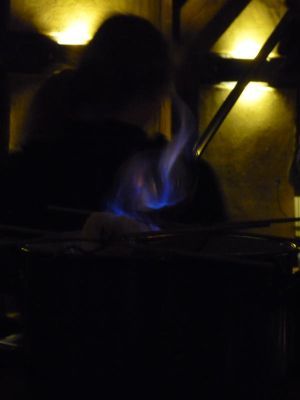
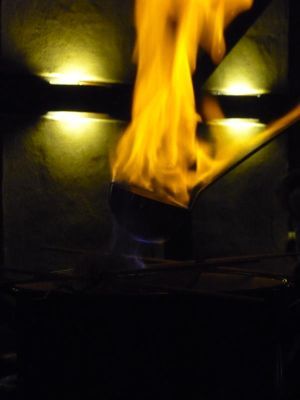
Toward the end of the festivity Rita led the children to a tender birch tree „to listen how the tree is growing“.
Once more we had enjoyed a special festivity at eye level with nature and with respect for nature.
Learning celebration in memory of Rabbi Leo Trepp
On Sunday, the 5th of December 2010, the fourth day of Chanukkah, we bid fairwell to Rabbi Leo Trepp. He was and remains for many of us an understanding and important teacher.
With a few concise words, a gaze or a gesture he was able to capture the essence of a subject matter.
Jalda, Anna, Channah, Chajim and many others shared their memories of the great rabbi with us. Their recounts were accompanied by nods of approval and smiles, because many remembered similar situations, in which Rabbi Leo Trepp delivered his message with humor, heartfelt warmth, sensitivity or justified indignation.
Channa describes her encounters in this way:
Who was Leo?
How does one write about a man, who has been written and talked about so often, who collected honorary titles and was the recipient of many speeches and texts in honor of his life and work?
My attempt to commemorate Leo Trepp can only turn out to be highly personal since I had the great fortune to get to know him personally.
I gained his friendship through my car, which had seat heating. Instead of driving straight to the synagogue he asked me to pass through Unter den Linden, which he visibly enjoyed and during which we received a lesson in Jewish history.
After arriving at the synagogue, he transformed the attendants in a matter of seconds into an intently listening prayer community.
Everyone will remember his powerful, deep and calm voice. His Drashot are still alive in us.
Unforgotten and long since incorporated in the rite and understanding are his wonderful instructions and explanations. Leo Trepp was a very strong personality, whose words and thoughts, encouragements and corrections have had a lasting effect into the present and beyond. Leo was a teacher by passion and profession. His unconventional, contemporary way of thinking was not only greeted enthusiastically by many people, but was also the impulse for a shift in thinking and a help and inspiration to venture along new paths. His openness and friendliness should always remain a role model for us. He has shown us time and again how to build bridges between different opinions, practices and schools. And despite all his delight for openness Leo Trepp always stayed true to his convictions.
Leo Trepp was a guide to so many people and he could give literally everyone a consoling, hopeful and foremost respectful word of advice. Leo Trepp recognized the abilities of each and everyone and encouraged each one of us to go his/her way undeterred.
A part of his gifts was his wonderfully quiet humor. I have never heard him make a joke to the detriment of others. In this sense I want to share an encounter which depicts who Leo Trepp was and how he affects more than any words could describe: At one of the last meetings with Leo Trepp we sat in a garden and I said:
”Leo, do you remember: when I drove you to the airport, you blessed us amidst all the bustle and noise at the check-in.”
„And, did it do any good?”
Channah Arendt
____________________________________________________________________________
Marlis and Claudia had studied the book "Your God is my God" by L. Trepp and G. Wöbken-Ekert and gave a small lecture about the history of conversions to the Jewish Faith. Marlis summarized the most important points of this topic for us:
The first part of the book gives us an overview of our history.
We learn of our father Abraham’s path to God and how his personality has shaped the ethics of the Jewish faith, Abraham was a Jew by free choice. We hear about the population growth and the proselytizing activities in the times of post-biblical antiquity. We learn that during the period of transition from antiquity to the Middle Ages the common attitude towards Judaism dramatically changed. Through the arrival of Christianity humiliation, defamation and brutal persecution was thrust upon the Jewish people. Despite all even in those times there were conversions to the Jewish faith. As a consequence of these events the Jewish communities stopped proselytizing in the Middle Ages. Leo Trepp teaches that the attitude of the medieval Jewish communities towards the new Jews is of importance, because it continues to affect and influence Judaism into the presence. We hear of the Age of Enlightenment up to the darkest time of our history. Life in that time had become very precarious and dangerous and it culminated in the Shoa.
Even in that era there were conversions.
Our history shows us that in all epochs non-Jews have joined Jews and their faith out of their free will and belief despite humiliation and the threat to their lives.
The second part of the book deals with the possibilities of conversion to Judaism in the present time. We find out about the different attitudes toward proselytizing in the different currents of Judaism. We hear that conversions are much easier in the US than in Germany. These descriptions are all completely free of judgement.
Leo Trepp gives from a rabbinical point of view future Jews of choice many important suggestions for the time of preparation and the conversion itself.
In the third part Jews of choice give in interviews an insight into their path to Judaism in Germany and the US.
Leo Trepp teaches us to show complete love and respect to every Jew of choice and to the Ger Toschaw. Just as Abraham had left Ur for his spiritual search, these human beings leave their innate origins behind to come after a long time of searching to the covenant of the Holy One. They have no privileges, only the privilege of responsibility.
Marlis Ventur
_____________________________________________________________________________
Afterwards Cantor Jalda spoke about conversions in the present time and lively discussions ensued.
Around six o’ clock there was a Maariw prayer and then we lit together with the children the fifth Chanukkah light.
Of course there belonged good food to all of this.
This learning celebration would have surely pleased Rabbi Trepp
Translation: Daniel Wiesenfeld
Sukkot 2010/ 5771
This year Ohel Hachidusch built 2 sukkahs; both were beautiful and both were built in cooperation with other groups leading to interesting plans for long-term collaboration.
September 22nd/ 14th of Tischri we celebrated erev sukkot in "Interkulturelles Haus Pankow". In the former school-yard of this building complex we had decorated our sukkah under the guidance of Chajim, -all branches, leaves and handicrafts made by our children together with Claudia. Some children even hung a special toy with personal meaning into the sukkah.


The atmosphere was great. On a clear sky we could see a bright moon and some stars through the greenery-covered roof. Cantor Jalda lead us through the liturgy and with increasing chilliness we even caught a glimpse of desert-night. At kiddush we gratefully enjoyed a delicious vegetarian pot-luck dinner. During the remaining festival days the sukkah was used for praying and learning: members of the Freie Schule Pfefferberg read Jewish fairy tales. Chajim lectured on the question if there is anything like Jewish porcelain. Jona read some chapters of her new book: "The sum of 1 is 13. An introduction to symbolism in the Hebrew bible" (literal translation of the German title). And Karsten Troyke gave a concert with Yiddish songs which was sponsored by the Kulturverein Prenzlauer Berg. We thank all helpers and organizations who contributed to the success of these festival days. Special thanks go to Chajim, the iniator and co-ordinator of this joint venture.
September 26/ 18th of Tishri Ohel Hachidusch commemorated Sukkot in a second location: we were guests in the newly inaugurated "Garden of World Religions" in Gatow, a picturesque suburb of Berlin. Under the guidance of Anna the neighborhood children built a beautiful sukkah which won the first prize as "Super Sukkah of Germany" sponsored by the newspaper "Jüdische Allgemeine Zeitung". Congratulations to Anna and her enthused, talented young master builders.
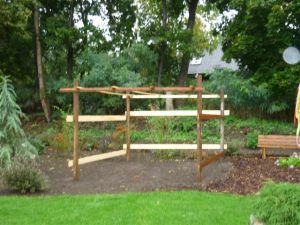
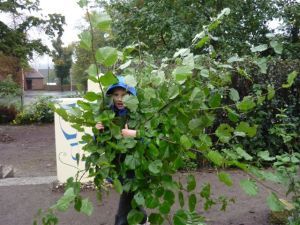


Until it started raining dogs and cats we had a short kiddush with all builders in our sukkah.
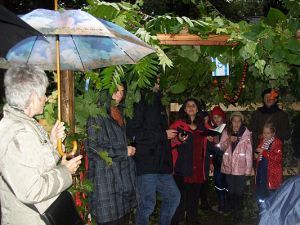 Foto: Rita Reinicke
Foto: Rita Reinicke The rest of the evening we enjoyed in the affectionately renovated pony stable of the estate Gatow. Cantor Jalda explained the Four Species and sang Yiddish songs, empathetically accompanied by Franka Lampe with the accordeon. Whoever experienced Jalda as cantor or in one of her concerts knows that she is opening hearts with her music and charism. Some hummed the melodies and even guests who experienced their first sukkot festival soon felt at ease.

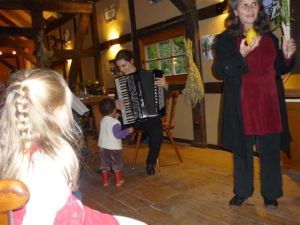


And once again Gaby Nonhoff surpassed herself with her exquisite buffet of delicious kosher specialities and even gave away one or the other secret of her recipes.
The Botanicum Gatow and its Garden of World Religions we wish rain, dew, sun and many visitors pausing for some minutes to receive new strength in this spiritual environment.
Dear Rita and dear Ulrich, thank you for your hospitality! It was a special experience to inaugurate the gardens and celebrate sukkot together with you.
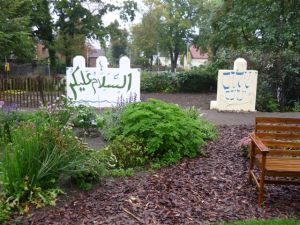
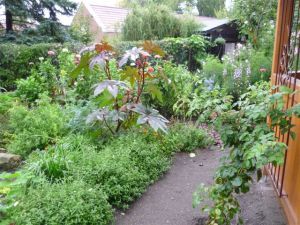
____________________________________________________________________________
Ohel Hachidusch moved to a new home
Since June 2010 we are praying, learning Torah and celebrating our festivals in a spacious new room in the parrish hall of the Lutheran Vater-Unser community. We set up our tent, our Ohel Hachidusch, and placed our Mesusot at the doorposts. We thank Rev. A. Werner and the Executive Board of Vater Unser Community for their hospitality and generosity.
Jona Kirchner introduced us with the following article in the " Vater Unser Gemeindebrief" 7/8 in 2010:
"What is Ohel Hachidusch?
The name of our group already indicates who we are, and what we stand for. The meaning of Ohel Hachidusch is “Tent of Renewal”. Ohel, the tent is a temporary home, which can be removed at any time for being rebuilt at another place. The tent symbolises the will for being open to start anew and to be ready for the adventure of new experience. Chidusch, the Hebrew word for renewal does not need further explanation. We are organised as a registered non-profit organisation that is associated with the movement for the Renewal of Jewish Life founded in the USA by Rav Zalman Schachter-Shalomi. Its umbrella organisation is ALEPH, the Alliance for Jewish Renewal. Also ALEPH has a symbolic meaning since it is the term for the first letter of the Hebrew alphabet with the numerical value of one. And the One refers to the one God, from whom all natural configurations and human interrelations originate.
During history Judaism passed through several transformations, and generated a lot of spiritual movements. Some of them still relevant for the structure of Jewish denominations today were developed only in the 19th ct, especially in the German region. Among these are the Conservative movement (founder Zacharias Frankl, Breslau) and the Reform of Judaism (with its prominent leader Abraham Geiger, Berlin). The movement of modern Orthodoxy at least has also developed here as an answer to the activities of the Reformers and Conservatives (prominent leader R. Samson R. Hirsch, Oldenburg/ Frankfurt/ M.). When Nazi Germany destroyed half of Europe, many representatives of these movements had to leave taking also their spiritual potential into exile. In both parts of America they gained new ground and underwent further development over about 40 years till they were given the opportunity to return to their places of origin.
With Jewish Renewal a totally new component is now added to the Jewish denominations already settled in Central Europe; it is supported by people coming from all the different movements - from Reform communities as well as from Liberal and Conservative Judaism. Renewal is welcoming also the branches of Orthodoxy, since it already draws a lot of its inspiration from their rich treasury of tradition. But unfortunately the members of Orthodox communities mostly do not understand why men and women should take equally part in the communal activities including all tasks in the service. But this is an indispensable part of Renewal’s philosophy and identity. As a consequence to that at Ohel Hachidusch currently a female Cantor holds office: Jalda Rebling is one of the leading founding members of the organisation and was ordained after having completed the Cantorial studies program of ALEPH.
Renewal also aims to help define Jewish identity based on its culture and tradition only. It is important to stop the spiritual influence of a history which left on European Judaism mostly the negative imprint of suffer and segregation. We set our hope much more in the healing power of Jewish tradition for the sake of our communities and their relations to other religious denominations in our country. In accordance with the intention of ALEPH we are open for an encounter with other religions like Christianity; and we are ready to learn from other traditions like those of Buddhism and Islam. Today we find ourselves in a comfortable situation where we have the chance of a peaceful interdenominational encounter. We especially experience the new reality in the opportunity to unfold our tent in a nice, big room offered by the Protestant community Unser Vater at Detmolder Straße in Berlin-Wilmersdorf. We are very happy to be there, and we invite everybody to get to know us and learn what we are doing.
Jona K. Kirchner, November 2010"
October 2/ 25th Tishri/ Shabbat Bereshit we celebrated our official move-in. Together with Rev. A. Werner and members of her congregation we conducted a havdalah-ceremony which was officiated by Cantor Jalda Rebling.
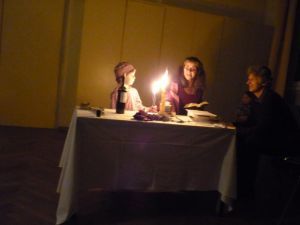

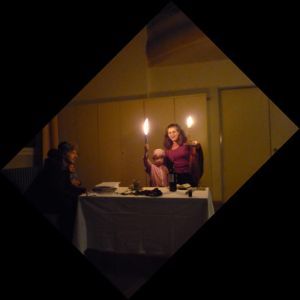
Ben (5 yeas old) assisted her enthusiastically. When looking at the pictures of our ceremony he commented:
"Luckily I did not burn myself. I was happy that I was invited. I was looking
forward to the food and liked it a lot. Did they all know that I am already
5 years old? I liked that I could hold the candles and that I could hand out
the leaflets. I was happy to see new faces. I was happy that everybody came,
only Etha was not there and that was sad. There were beautiful angels . The
celebration and the whole room were beautiful and prepared with loving care.
But I was afraid that the room might burn down when Jalda put out the candle
in the wine. Actually the song that the one man was singing was a little
sad. I liked that the whole family was out in the evening."
Thereafter we placed Mesusot at the doorposts at the entrance of the parrish hall and our room as visible sign of our move-in.
The Mesusah at the door post of our room showing Naomi and Ruth (lower picture) is handmade pottery created by Chajim. Dear Chajim, thank you very much, also for all good wishes, positive thoughts and touching memories which you included into your work.
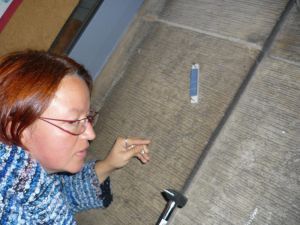
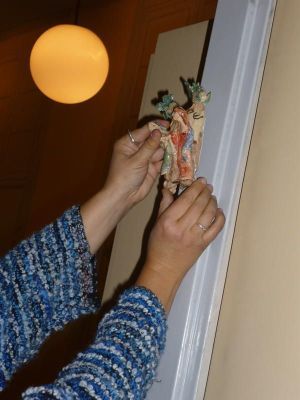
Channah wrote down her thoughts which occurred to her while the Mesusot were affixed:
A small, quite manifold group of people of different religions and origins shared a spiritual experience. The Vaterunser Congregation offered Ohel Hachiddusch a constant "tent of renewal". We are invited and welcome. As symbol of this solidarity we jointly attached mesusot. As instructed by the Torah we placed the first mesusah at the post of the entrance door to the building. Everybody sang "Iwru, iwru bashearim panu derech haam..." and with these powerful words we passed the open door, climbed the stairs and still singing entered the hall in the second floor where we have been permitted to celebrate our services.
The mesusa which we attached at the entrance to the hall shows Naomi and Ruth.
"Intreat me not to leave thee or return from following after thee: for whither thou goest, I will go; and where thou lodgest, I will lodge: thy people shall be my people, and thy God my God." (Ruth 1;16. JPS 1917).
The pottery artist Chajim Grosser chose the motive of this mesusah with great attention:
Vaterunser Congregation turned into a meeting place of two religions in chessed and agape. Symbolically the younger one turns toward the older one with care. "A place is with whom you are" (Berlin, 1996) wrote Rabbi Levinson. Even more so: in our multifaceted group the Protestant minister Annemarie Werner announced that Dhiraj Roy would sing a sacred song from the Upanishads for us. Mr. Roy is Hindu and was born in India. For all of us he sang a hymn in Sanskrit praising God the Creator of the Universe. The Upanishads were composed about the year 1000 BCE.
Singing we pray. We can intent this only when we have heard God beforehand.
Our Father, Awinu, the Eternal, is calling us: Schema, hear:
"Thou shalt love the Lord thy God with all thy heart and with all thy soul and with all thy might....And thou shalt write them upon the door-posts of thy house, and upon thy gates." (JPS, Deuteronomy 6; 5+9).
We thank everybody who participated and helped to transform this event into a mutual spiritual experience.
Channah Arendt"
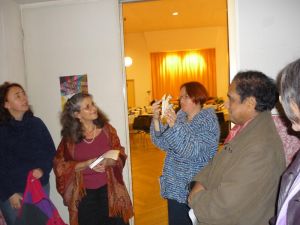
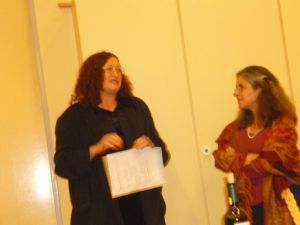
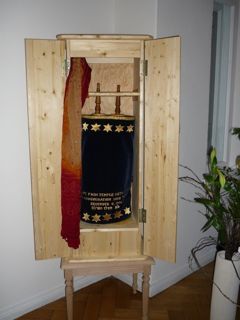
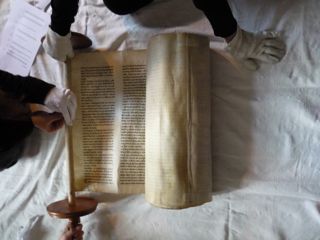
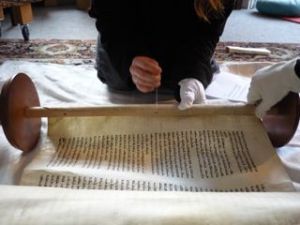
As part of the "Torah Active Kiddushim" Program the congregation Shir Tikvah from Troy/Michigan donated their Beth Jacob Torah to Ohel Hachidusch in December 2008.
The oldest parts of the Torah date back to the 18th century. It is assumed that it was written in Czechoslovakia.Therefore Shir Tikvah decided that the Torah should return to Europe. Cantor Jalda Rebling received the Torah in a moving ceremony in Michigan and brought it to Berlin.
Anna built a portable wooden Aron HaKodesch.Once its design stood the test the Torah will get a new home made of the most suitable type of wood: light-weight, airy and beautiful.
___________________________________________________________________________________________




January 2010: Thank you, Shir Tikvah for these pictures! Chajim´s ceramics for the
havdala ceremony, our wimple for the Blumenstein-Family Torah and our Ohel-documentation are at home.
(For details check article below on our torah celebration).
___________________________________________________________________________________________
This article was written by Rabbi Arnie Sleutelberg from Troy/Michigan after his visit in Berlin for our mutual Torah Celebration on November 28, 2009:
Die Rolle aus Amerika
The Torah Scroll from America
FEIER Ein Rabbi aus Detroit liest aus der Tora, die seine Gemeinde Berlin schenkte
CELEBRATION A rabbi from Detroit reads from the Torah which his congregation had gifted to Berlin
So read the headlines of a feature article in the Berlin Jewish News, the “Jüdische Allgemeine.”
http://www.juedischeallgemeine.de/epaper/pdf.php?pdf=../imperia/md/content/ausgabe/2009/ ausgabe49/14.pdf
After deciding to commission the writing of a new Torah, the Board of Trustees of Congregation Shir Tikvah decided to share our good fortune by passing forward a Torah which had been gifted to us by Temple Beth Jacob in Pontiac. We sought to find a deserving, viable, egalitarian congregation for whom this would be their only Torah. A Torah donation committee was formed, applications were distributed around the world on the internet, and nine deserving applications were received. The committee narrowed the field to three and the Board of Trustees chose Ohel HaChidusch in Berlin, Germany for several reasons. First, they are egalitarian and viable with devoted leadership. Second, unlike other Berlin congregations, they are welcoming of the intermarried, as well as those who, 60 years after the Holocaust, are attempting to reconnect with their Jewish ancestry (though technically not yet Jewish themselves). And like Shir Tikvah, they are welcoming of the Lesbian, Gay, Bi and Transgender community.
In Shir Tikvah’s new Ark a place of holy memory will always be kept for our Holocaust Torah. It came to us because its congregation in Eastern Europe was destroyed. However, now that there is a resurgent Jewish community in Eastern Europe, even in Germany’s capitol, it is fitting that we return a Torah, the Beth Jacob Torah, to Eastern Europe, to Berlin, in a clarion call proclaiming that Am Yisrael Chai, the People of Israel lives.
At our Dedication Ceremony last December, representing Ohel HaChidusch was their spiritual leader, Cantor Jalda Rebling. Our President, Erica Peresman and our Torah donation committee chair, Eileen Nowikowski, passed the Beth Jacob Torah to Shir Tikvah’s Holocaust survivors, Edith Bernstein, Wolf Gruca, John Kovacs and my Mom, Edith Sleutelberg, who, on our behalf, passed the Torah to Cantor Rebling.
In the most moving moment of the evening, Cantor Rebling accepted the Torah, tearfully thanked the congregation, and slowly walked off the Bima and down the aisle as the congregation equally tearfully sang, “May You Be Blessed As You Go On Your Way” by Debbie Freedman. This moment proved once again what we all know already; that as great as it is to receive, it’s even better to give.
Nearly a year later, Congregation Ohel HaChidusch hosted its Torah Consecration ceremony in the sanctuary of what was formerly a Jewish orphanage. With representatives of the Christian and Muslim faiths in attendance, 3 rabbis, 1 cantor, 20 people connected to Shir Tikvah, and dozens of others, the Beth Jacob Torah was taken from its newly constructed Ark, unwrapped from its newly embroidered Wimple, unrolled, read, and consecrated. Seven times a portion was chanted, and beautiful Divrei Torah with blessings were shared, many by Shir Tikvah members. I had the privilege of chanting the Priestly Benediction.
Irv Wengrow from Troy shared that being a part of the Kabbalat Shabbat service and Consecration helped him to know that we had made the right decision in gifting the Torah to Ohel HaChidusch. A film crew documented the evening as well as reporters from Berlin’s newspapers. It was thrilling to be a part of this historic event.
Ohel HaChidusch, because it is welcoming of those who are shunned from other congregations, has had difficulty obtaining funding or any assistance from Berlin’s Jewish community. How sad that they are discriminated against as a congregation for being open and welcoming. Many descendants of pre-war Jews are discovering their Jewish roots and are desirous of connecting with the Jewish community while pursuing conversion. Unlike other Berlin congregations, Ohel HaChidusch is welcoming of those who wish to learn, experience and grow into their Judaism.
In addition to participating in the Shabbat and Consecration services, we toured Berlin, taking in the sites of East and West, the remnants of the wall, the new government buildings, the Reichstag, the Holocaust Memorial and Museum, and numerous other memorials and cemeteries. But most of all, we listened to stories … of the war, the wall, Jewish life under communism, and the resurgent Jewish community.
Cantor Jalda Rebling was born in Amsterdam just after the war. At the age of 2 her family moved to East Berlin in a futile effort to help build a socialist country of the highest standards. And there she has lived ever since. She was active in the movement that ultimately tore down the wall.
In a rare swift example of “what goes around, comes around,” Cantor Jalda has accepted an offer to be Shir Tikvah’s High Holy Days Cantor this fall. Ohel HaChidusch is always lay-lead for the High Holy Days in order to be able to afford Cantor Jalda the rest of the year. She will grace our services with her angelic voice and soulful spirit. And, as Scholar-in-Residence, she will be in Troy January 15-16 for services and a Shabbat afternoon pot-luck third meal with Havdallah.
As the son of Holocaust survivors, for me anything German was loathed. Buying anything German was impossible, let alone traveling there. Many times during our trip I asked myself, “What am I doing here?” But most of the time I found myself impressed with the deliberate way modern Germany deals with its past and consciously learns from it. The Holocaust is ever present in Berlin, as it actively informs Germans how to make their present and future more civilized. It appears to me that a future holocaust could happen in most any place around the world sooner than in Germany.
_____________________________________________________________________________________
Torah celebration on the 28th of November 2009/ Erew 12. Kislew 5770
On the 28th of November 2009 a very special event took place under the roof of Ohel Hachidusch. Together with Rabbi Arnie Sleutelberg and many members from the Shir Tikvah Congregation in Troy/Michigan, USA as well as a large number of participants and honorary guests we rejoiced in our Torah celebration.
Preceding history:
On the 13th of December 2008/ 17. Kislew 5769 Shir Tikvah presented the Beth Jacob Torah to our Cantor Jalda Rebling after having chosen from 9 applicants. The Rabbi of the congregation Reb Arnie Sleutelberg describes the moving ceremony:
"One of the most moving moments at Shir Tikvah was in December, when we presented our Beth Jacob Torah to Cantor Jalda to take to her congregation, Ohel Hachidusch, in Berlin, Germany at our Torah Alive! consecration service last December. Witnessing our Holocaust survivors place the Torah into her arms left us all with tears streaming down our cheeks. She accepted the Torah with tearful emotion, and then walked down the aisle as we sang “May you be blessed as you go on your way.” We knew that we were witnessing a profound moment in the history of the Jewish people as our Torah began its way to Germany." ((www.shirtikvah.org).
Shir Tikvah had received the Beth Jacob Torah as a donation in its first years of existence. Today Shir Tikvah is a strong congregation, which has its own Torah, the Blumenstein-family Torah, written by the Soferet Jan Taylor Friedman.
Instead of keeping the Beth Jacob Thora stored in the Aron Hakodesch without ever being read, the members of the congregation decided to pass on their first Torah to a small, young community, which didn’t yet have its own Torah. Nine applications from the US, Europe, South America and Israel were submitted. The board of trustees of the congregation of Shir Tikvah chose Ohel Hachidusch e.V. from Berlin.
Since one year now the Beth Jacob Thora has been in Berlin and teaches Jewish knowledge to a small, creative Jewish community. Religious services and teaching seminars take place on a regular basis. There is learning and discussions, singing and cooking, Jewishness is being celebrated.
Kabbalat Shabbat and Torah festivities:

On the 27th of November the moment had finally arrived: we could welcome Reb Arnie Sleutelberg and 19 additional members of his congregation to the Kabbalat Shabbat in Anna Adam’s studio. It was a moving service, which was held by Reb Arnie Sleutelberg together with our cantor Jalda Rebling. Chaijim Grosser offered a special surprise: he gave our guests handmade, artful ceramics for the Hawdala ceremony. Afterwards there was a Kiddush. While enjoying the delicious food lively talk and interesting conversations ensued. The relaxed and warm atmosphere raised the happy expectation for the following evening.
Our Torah celebration took place on the evening of the 28th of November. We are very thankful that we could welcome Rabbi Tovia Ben-Chorin, liberal Rabbi of the Jewish congregation of Berlin and Rabbi Walter Rothschild, Rabbi of the state of Schleswig-Holstein as honorary guests.
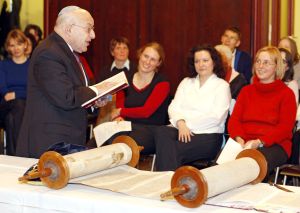

We celebrated at a historical location: the praying room of the former Jewish orphanage in Berlin-Pankow. The orphanage was founded in 1882 and housed at times up to 100 orphans. They were deported to the concentration camps in 1940. Each of us felt the emotional density of this space, in which for the first time since 1940 the Torah was read again. A large hole in the wall was purposely left untouched in the room, otherwise beautifully renovated by the Cajewitz-foundation: That was the location of the Aron Hakodesch of the orphanage, which had been torn out of the wall. Now a few meters away stood our own moveable Aron Hakodesch, built by Anna Adam, with the Beth Jacob Torah inside, whose individual parts are between 70 and 200 years old and surely have experienced a lot as well, before they were taken from, most likely, former Czechoslovakia to the United States to safety.
After the Hawdala, which was lead by Reb Arnie Sleutelberg and Cantor Jalda Rebling, Anna Adam lifted the Beth Jacob Torah out of its shrine after a short introductory speech. In a festive procession the Torah was then brought to the middle of the room and unrolled on top of a long table.
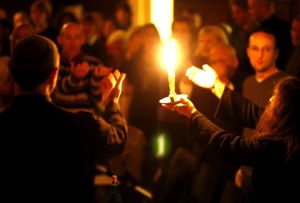
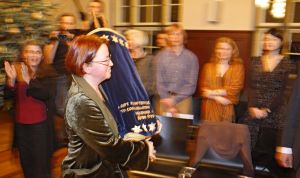
A Wimple, which had been made by all of us under the knowledgeable guidance of Ella carefully held the Torah together, presenting an Ashkenazi custom from the middle ages. We, approx. 90 people, sat in a large circle around the Torah, so that everybody was close enough to really be part. Some of us had never before been this close to a Torah.
Now came the high point of our festivity: The Beth Jacob Torah has nine seams at which the old pieces with various ages had been joined together. Precisely these sections were read aloud, commented on and honored with blessings by our three honorary guest Rabbis, by members of Shir Tikvah, by Oren Roman from Jerusalem as well as by our cantor Jalda Rebling, by Jona and by Anja of Ohel Hachidusch. Further honorary guests were Rev. Christian Zeiske of the Gethsemane Church and Myriam and Gitti-Fatima, two Muslim friends.

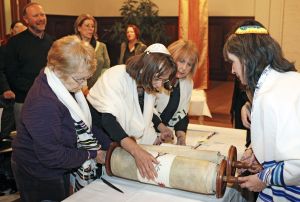

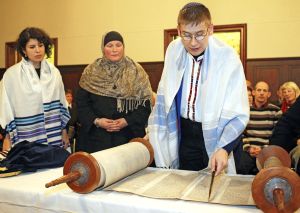
The Beth Jacob Torah has arrived in Berlin.
After the Torah had been brought back into the Aron Hakodesch and Rabbi Tovia Ben-Chorin had said the Kaddish Rabanan, Angela presented to our American guests an approx. 7 m long Ohel-roll with personal accounts and statements by our members, with photos and Ohel Hachidusch’s acclaimed Kiddush-recipes. In her speech Angela brought together many aspects of what had moved us during the celebration. Her words as follows:
“Dear Arnie, this is a little present from our group Ohel Hachidusch. Since our meeting yesterday evening and celebrating the Shabbat together, I think you and also the other members of Shir Tikvah realized how important your present of the Beth Jacob Torah has been for us. It was an important step in the process of taking on more responsibility. But for us as a group it also meant that you saw the importance of building a new Jewish religious life in Germany after the Shoah, in which also the new developments are incorporated. We want to thank you for this opportunity. This present is also like a little Torah and it includes some very personal accounts of some members of Ohel Hachidusch over the last two years, since we have become a more stable group. Many thanks for your visit to celebrate with us here in Berlin.”
Anja gave our guests from Troy a Wimple, which had also been hand-made by us, for their new Blumenstein-Family Torah. (Check below for Anja`s speech).
Then followed inspiring words by Rabbi Tovia Ben-Chorin.
The entire evening was woven together by all of us with songs, nigunim and chants under the direction of our cantor Jalda Rebling. Rabbi Walter Rothschild then led the Kiddush. The culinary delights had been prepared by Gaby Nonhoff and many talented hobby cooks from Ohel Hachidusch and served by many helping hands. With song and personal conversations the evening reached its end. Many thanks to all, who had made this a special spiritual experience.
Special thanks to Ruth and Daniel for translation.
(This text turned out to be extraordinarily long. However the celebration was so important for us as a community that a short description would not have sufficed).
All photos by Marco Limberg
Nov.6th to 8th 2009: Workshop with Rabbi Shefa Gold: Path of Love
We enjoyed the great privilege to experience Rabbi Shefa Gold from Jemez Spring, New Mexico, USA in a workshop here in Berlin. She is one of the leading personalities of Aleph – the Alliance for Jewish Renewal- and following the invitation of Ohel Hachidusch e.V. she came to Germany for the first time. She received her ordination from Reconstructionist Rabbinical College and Rabbi Zalman Schachter-Shalomi. Her compositions and liturgies found their way into modern Siddurim. Rabbi Gold trains Rabbis, Cantors and lay leaders in the context of Kol Zimra, a special two-year program. She works with the Institute for Jewish Spirituality in New York The energy and inspiration for her work she not only draws from her Jewish roots but also from Buddhist, Christian and Islamic traditions as well as from spiritual strands of native Indian culture. She creates connections, where these traditions meet one another at the access to the one source of love.
Channah summarized the particularity of this workshop as follows:
„Path of Love, which was conceptualized and realized by Rabbi Shefa Gold, is a sensitive and professional instruction for the meaningful, quiet approach to the nurturing sources of our Jewish texts. Path of Love also means to discover oneself and one’s abilities to create a community.
Structured as a Shabaton Shefa Gold lead us by means of teachings and chants far into Hawdala in the course of a unique Shabbat.
We know these texts from Siddur and Tenach, Rabbi Shefa Gold however offers us an entirely new insight into the depth and beauty of these words through her teachings. By chanting together we experience and come in contact with the force hidden in these words. In the ensuing silence we have space and time to absorb reconciliation, healing, growth and the reanimation of tenderness.
We encounter the texts with attentive minds and open hearts. Under the guidance of Rabbi Shefa Gold we learn fast and almost without noticing to be loving and caring.
Quietly yet clearly perceptible a communion is growing. We celebrate Shabbat.
At the end she poses the question: in which way do you want to take something of what you have learned into your daily life and commit yourself to living accordingly?
Path of love is a way of living.“
(Translated by Ruth and Daniel).


Rabbi Shefa Gold (right) in her workshop "Path of Love"
______________________________________________________________________________________________